Chapter 29
Practice Exam 2: Answers and Explanations
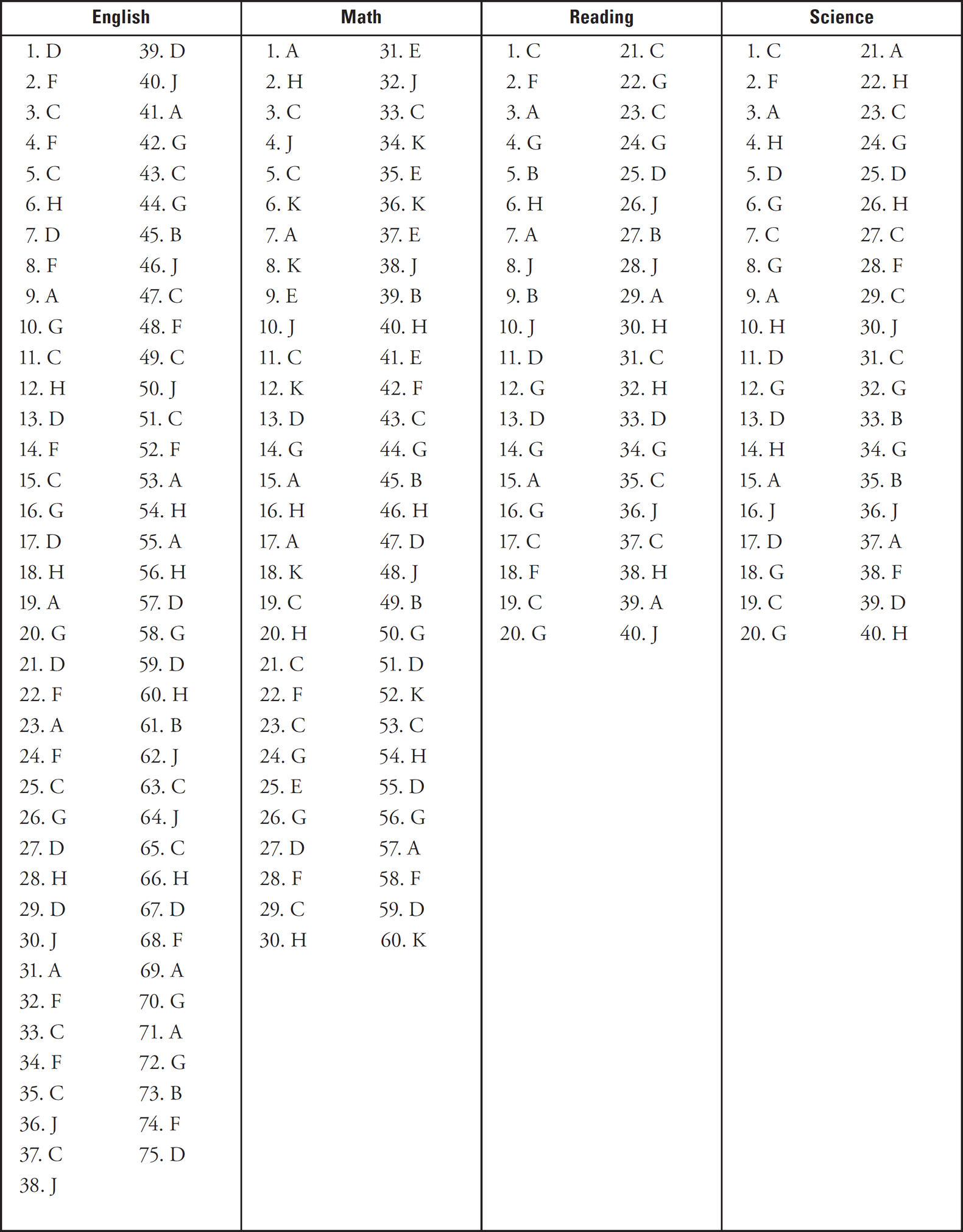
ENGLISH TEST
1. D
The verb associate requires the preposition with. None of the other choices are idiomatically correct.
2. F
All the proposed substitutions essentially expand upon the word genders without adding any new information to the sentence. As a result, you can eliminate (G), (H), and (J) because they are all unnecessarily wordy.
3. C
You can eliminate (A) and (B) right away because the proposed sentence is totally out of context with what you’ve read so far. Only (C) gives the correct reason why you shouldn’t include the proposed sentence: the content of the sentence is irrelevant to the passage as a whole.
4. F
Eliminate (H) and (J) immediately because these will not be correct under any circumstances. Only (F) uses the correct form of the past participle.
5. C
Choices (A) and (B) contain punctuation that is used to separate complete ideas. Since Once you’ve learned a few basic stitches is not a complete idea, neither answer choice can work. Instead, once you’ve learned a few basic stitches operates more as an introductory idea, which must be set off with a comma, as in (C).
6. H
In this situation, (H) is the most concise answer that makes sense in the context. Notice all the other choices contain redundant words and phrases.
7. D
This sentence is talking about the completion of several projects. Only (D) has the appropriate plural pronoun. If you picked (B), be careful: Pronouns must agree in number.
8. F
Since you can count the starter kits (there are three, as the passage says), use fewer rather than less. With that, you can eliminate (H) and (J). Next, you need to use than, which is a comparison word, rather than then, which is a word used to describe a sequence of events in time. Only (F) works in this sentence.
9. A
No change is necessary here because no pause is needed after the word types. Choices (B) and (C) in particular use punctuation that is much too strong in this context.
10. G
Use Process Of Elimination aggressively here. The idiomatic phrase ranging from should not be split up with a comma, so eliminate (F) and (J). Then eliminate (H) because ranging from very small to very large, with everything in between is not a complete idea. Only (G) works in the context.
11. C
This sentence talks about hooks that make big stitches so it needs to be moved closer to sentences about hooks big enough to do that. Only Sentence 3 works, because it talks about large hooks.
12. H
Choices (F) and (G) don’t make sense in the context. These are actually ideas with a negative slant and would be more appropriate in a sentence that was talking about some negative aspect of crocheting. Choice (J) might have worked better in the first paragraph. In this paragraph, however, (H) provides the most effective lead-in.
13. D
As written, this sentence contains a comma error in its use of a comma to separate two complete ideas, so eliminate (A). Choices (C) and (D) both contain words that make the first part of the sentence incomplete, but (C) suggests a contrast where none exists. Choice (D) is the correct answer because it fixes the complete problem and contains the appropriate transition word.
14. F
Only (F) gives the idiomatically correct preposition. The others change the meaning of the sentence or use incorrect idioms.
15. C
The essay is clearly in favor of crocheting, but it has not discussed the commercial potential of crocheting at all, so you can eliminate (A) and (B). Neither has it talked about the commercial potential of any other hobby, so you can eliminate (D).
16. G
The verbs in this sentence are fairly complex, so use Process of Elimination aggressively. You can eliminate (F), (H), and (J) because all would be used in a situation in which the author had seen the painting. In the context of this sentence, however, the author is trying to suggest that she never believed that she would see the painting, so only (G) can work.
17. D
This sentence may sound correct as written, but be careful. If you’re going to use the chance to construction, you must complete the infinitive. In other words, in this situation, the sentence would have to read, I finally got my chance to see the painting. In this case, the only possible solution is to delete the underlined portion. Note that this is the most concise answer that works. Always give these deletions and omissions special consideration—they can often get some of the tangled logic out of the sentences as written.
18. H
This sentence refers to the grandeur of the painting. In other words, you need the possessive pronoun its when describing the painting’s grandeur. Only (H) works.
19. A
The verbs in this sentence form a kind of list, so make sure all the verbs in the sentence are consistent (or “parallel”) with one another. The verbs should read packed, jumped, and headed. Only (A) keeps all three verbs consistent with one another.
20. G
The proposed insertion has the word her right at the beginning, which means that you need to find the sentence that contains its antecedent. Notice the clause in Sentence 3, I met someone else who loved the painting as much as I did. This someone else is the correct antecedent for her in the paragraph.
21. D
There are incomplete ideas on either side of this sentence, so you can’t use either a colon or a semi-colon. Even a comma gives the sentence a pause where none is necessary. Only (D) gives the sentence its appropriate flow and does not break up the subject and its verb.
22. F
Notice the word impossible directly before the underlined portion. Since this word is not underlined, it can’t be changed, thus making (G), (H), and (J) redundant.
23. A
Sentence 1 does talk about the size of the canvas, but Sentence 2 is out of context in this paragraph. This paragraph is about the author’s impressions of the painting; the kind of technical detail presented in Sentence 2 is not part of these impressions.
24. F
Remember that transitions are used to connect the ideas in paragraphs. The previous paragraph is about the author’s impression of the painting, particularly relating to the size of the painting. The new paragraph goes on to present the author’s impression of another element of the painting, which she finds even more impressive, as in (F). Choices (G), (H), and (J) might work in a different context, but they don’t connect these paragraphs as well as (F).
25. C
Notice that (A), (B), (D), and the underlined portion of the original sentence all contain the conjunctions as and When. The absence of any of these conjunctions in (C) creates a comma error, and (C) is therefore NOT an acceptable substitution.
26. G
From a distance is the first part of the contrast in this sentence, the second part of which is up close. If you were to delete the prepositional phrase from a distance, this contrast would be unclear.
27. D
The subjects of these paragraphs have been the author and her friend, so of all the answer choices, only (D), which contains the first-person plural pronoun we, could work here.
28. H
This essay has been about the author’s love of a single painting, so there is no need to mention other paintings at this point in the essay; eliminate (F) and (G). You can also eliminate (J) because this information is not contradicted elsewhere in the passage.
29. D
No pause is necessary between sights and on our trip, so eliminate all answer choices that suggest this pause with unnecessary punctuation.
30. J
The only clear placement for the underlined portion is after the word bought, completing the phrase bought at the museum gift shop. The other answer choices make the sentence unclear.
31. A
The idea cats have developed is not complete, so a semicolon can’t be used after it. Eliminate (D). In fact, no pause is needed anywhere in this sentence, so any of the choices that introduce unnecessary commas can be deleted. Choice (A) is the only choice that does not contain unnecessary pauses.
32. F
Make sure you read the question carefully. It’s asking for something that expresses the ownership relationship between people and cats. Choice (H) can be eliminated because it talks about dogs, and (G) and (J) can be eliminated because they don’t express the ownership relationship for which the question is asking.
33. C
In this sentence, the phrase When communicating with each other is a misplaced modifier. As written it sounds like the “talk” is somehow communicating with each other. It is of course the cats that are communicating with each other, which means that only (C) fixes the misplaced modifier.
34. F
First, since this question is testing changes in verb tense, identify the subject of the verb. In this case, the subject is the plural noun tails, which requires a plural verb. You can eliminate (H) immediately, and (G) makes the sentence incomplete. Choice (J) changes the meaning of the sentence and uses a wordy passive construction. Given the new mistakes in all the proposed substitutions, the correct answer is (F).
35. C
The paragraph has been discussing the ways that cats communicate nonverbally. The sentence gives an exception to this rule, which only (C) adequately describes.
36. J
You’ll want to begin a new paragraph here because the focus of the essay changes with the introduction of the word human. Because this sentence is not describing a step in a process, and there’s no first idea for which this can be the next, you can eliminate (H). Only (J) works.
37. C
Use context. The previous sentence is describing plural cats, so this sentence should do the same. Only (C) gives the correct possessive form of the plural, cats’.
38. J
Choices (F) and (G) are redundant. The word logical alone gets the point across here. Choice (H) modifies logical, but it does so unnecessarily—to a startling degree is not specific. Only (J) is concise while preserving the meaning of the sentence.
39. D
Clear is an adjective, which modifies a noun; clearly is an adverb, which can modify a verb, an adjective, or another adverb. The word being modified here is demonstrated, which is a verb, so you’ll need the adverb clearly and can eliminate (A) and (B). Choice (C) can’t work because the conjunction since is not the appropriate transition between ideas in the sentence. Only (D) contains the correct adverb with the proper transition when.
40. J
The information given is true and may be interesting, but in the context of this passage, it would be out of context. Remember, this is a passage about cats, so it is not at all likely that a sentence about birds will contribute to the main idea of the passage.
41. A
The structure of this sentence is clumsy, but you can change only what appears in the underlined portion. In this instance, your most important clue is the comma after the word examples. This comma suggests that the infinitive phrase to name only a few examples is being set off as unnecessary to the meaning of the sentence. The sentence as written is the only choice that does not contain a grammatical error.
42. G
Of all the possibilities listed here, only (G) establishes any kind of link between cats and their owners. Other answer choices talk about mammals, but this question asks specifically about cats.
43. C
The underlined portion must be parallel with the rest of the sentence. Early in the sentence, the author speaks of communicating as every bit as important as forging good relationships. A second as will be needed to complete the comparison, and any verb used will need the same conjugation as forging. Choices (B) and (C) both meet these criteria, but of the two, (C) is more concise.
44. G
Choice (G) is the most concise substitution that maintains the meaning of the sentence. Choices (F), (H), and (J) are redundant because they contain some form of the word senseless and other words that mean the same thing.
45. B
Some of the transition words offered in the answer choices may seem similar, so it is best in this situation to compare what comes after those transition words. Again, you need an answer that expresses the relationship between cats and their owners. Although the word human does not appear in it, (B) is the only one of the answer choices that talks about a relationship between cats and humans.
46. J
Choices (F), (G), and (H) all give redundant constructions. Only (J) gives a concise construction and maintains the meaning of the sentence.
47. C
The houses described here are not in possession of anything, so you can eliminate (A) and (B). You can also eliminate (D) because it introduces an unnecessary pause after the word houses.
48. F
Only (F) maintains the meaning of the subject without introducing new, unnecessary information. Choice (J) might look appealing, but (F) is still more concise. Think of it this way: To say the same thing, (F) takes one word and (J) takes two. Go with the most concise choice that works.
49. C
Michigan island is a compound noun in this case, so the adjective isolated should not be set off from Michigan with a comma. Eliminate (A) and (D). Notice so, one of the FANBOYS, directly after the underlined portion. FANBOYS need a comma to link two complete ideas. Only (C) works.
50. J
All items in a list must be consistent. In this sentence, the list should read by horse, carriage, or bicycle. Choices (F), (G), and (H) are not consistent.
51. C
As written, this sentence creates a comma error. The idea that ends with the word necessary and the idea that begins with the word Mackinac are both complete, so of the different possible punctuation marks in the answer choices, only a period can be used to separate them.
52. F
If the end of this sentence were deleted, the meaning of the sentence would not fundamentally change, but you would lose an interesting detail about Arch Rock, as (F) suggests. Choice (G) is misleading in that it suggests the geological descriptions of multiple tourist attractions, while the underlined portion gives the geological description of only one attraction. There is no contrast with the governor’s mansion, so eliminate (H); the information is not detailed elsewhere in the passage, so eliminate (J).
53. A
The next sentence discusses fudge, and only (A) contains any mention of stores that might sell this product.
54. H
This question is testing the idiom for sale. The only viable alternative to this would be on sale, but that doesn’t appear in the answer choices. Choices (F), (G), and (J) all suggest incorrect idioms.
55. A
Choices (B), (C), and (D) are all grammatically correct while preserving the basic meaning of the sentence. Choice (A), which, is neither grammatically correct nor consistent with the meaning of the sentence. Therefore, (A) would NOT be an acceptable alternative.
56. H
Only (H) removes the redundancy problem and maintains the meaning of the sentence.
57. D
The pronoun in this portion of the sentence should refer back to the local residents. As such, it should be a third-person plural. Only (D) has the appropriate pronoun, they.
58. G
Of all the answer choices, only (G) reduces the wordiness of the sentence while clarifying its meaning.
59. D
The subject of this sentence is privacy, so the verb in the underlined portion must agree with a singular noun. Eliminate (A). Choices (B) and (C) change the meaning of the sentence by changing the tense of the helping verbs. Only (D) maintains the meaning of the sentence and fixes the verb-conjugation problem.
60. H
This passage discusses Mackinac Island as a tourist destination and mentions cars only in the beginning of this essay. If the writer’s intention is to show the difficulties residents have with cars, this essay has not succeeded; its subject has been the island itself and its many tourist attractions.
61. B
The two nouns friends and peers are not part of a list or separate ideas. Instead, they are both the objects of the prepositional phrase in front of, and they should thus not be separated with any punctuation.
62. J
Choice (J) is grammatically incorrect because it makes the sentence unable to stand on its own (i.e., it changes the sentence from a complete idea to an incomplete idea). It is therefore NOT an acceptable alternative to the underlined portion.
63. C
Sentence 2 refers to something that defies understanding, and the word though suggests that something in a previous sentence does not defy understanding. Sentence 4 reads, It is understandable that people would enjoy singing in the privacy of their homes. Sentence 2 should follow this sentence because it describes, by way of a contrast, something that is not so understandable.
64. J
Notice the other verb in this sentence, see. These verbs should be consistent; the basic subjects and verbs of each part of the sentence should read look and you’ll see. Only (J) contains the consistent verb and maintains the meaning of the sentence.
65. C
The Even though at the beginning of this sentence operates as a conjunction, thus making everything up to busy restaurants part of a single incomplete idea. Choices (A) and (C) set this idea off with a comma correctly, but (A) has the FANBOYS but. A coordinating conjunction preceded by a comma can be used only to separate two complete ideas.
66. H
The phrase such staples as should not be divided with any punctuation. Only (H) gives the appropriate absence of punctuation. In order to use a colon, the idea before the colon must be complete. This one is not, so you can eliminate (G).
67. D
The verb in the underlined portion must be consistent with the other major verb in this sentence, responds. Only choice (D) establishes this consistency. Choices (A) and (C) are in the wrong tense, and choice (B) makes for an awkward construction.
68. F
The beginning of the next paragraph speaks of another, more obvious reason. The underlined portion, therefore, must contain a reason of some kind. Only (F) contains anything close, particularly in the final idea, this is not the only reason for its enduring popularity. The other answer choices do not link these two paragraphs, nor do they make sense in the larger context of the passage.
69. A
This sentence should be in contrast with the previous sentence, and the sentence as written signals this contrast. The others give adverbs that suggest a comparison rather than a contrast.
70. G
This sentence needs something that will suggest that the quality of people’s voices doesn’t matter. Only (G) does this with the word regardless. The prepositional phrase in lieu of suggests a substitution, but nothing is being substituted here; rather, the poor singing of many of karaoke’s participants is being disregarded in consideration of other, more important things.
71. A
Choice (D) gives the contraction who is, which does not work here, so you can eliminate that immediately. Choices (B) and (C) are not grammatically correct in this situation. The sentence as written contains the appropriate possessive pronoun and should therefore not be changed.
72. G
The clause who are ordinarily shy is important in its modification of the word people. It would be incorrect to say that in general, karaoke brings people out of their shells. The clause is necessary because it clarifies that the sentence is talking about people not normally inclined to perform in public.
73. B
The word first indicates that the underlined portion will need to have something to do with time. Choice (D) suggests a place, so you can eliminate it. Choices (A) and (C) suggest a cause and effect that is not substantiated in the rest of the sentence. Only (B), when, gives the appropriate time word.
74. F
If you are not sure how to use less and fewer, look at the second word in each underlined portion. Then refers to a sequence of events; than is a comparison word. In this sentence, the author is making a comparison, so you need than. Eliminate (H). Now (F) is the only choice that makes the sentence grammatically correct. As a general note, less is used with general quantities (e.g., less money) and fewer is used with quantities that can be counted (e.g., fewer dollars). This question actually tests an exception to the rule in which both adjectives can work depending on the context; if were you to expand this sentence, it would read less money than $7 billion rather than fewer than 7 billion dollars.
75. D
This passage deals with the international popularity of karaoke. At no point does the passage discuss specific regions. Therefore, the proposed insertion would not be appropriate at any point in the passage.
MATHEMATICS TEST
1. A
The midpoint of segment XY is the average of X and Y, so add them up and divide by 2:. 
2. H
Use the Pythagorean theorem (a2 + b2 = c2) to find the length of DE: 82 + (DE)2 = 102, so 64 + (DE)2 = 100, (DE)2 = 36, and DE = 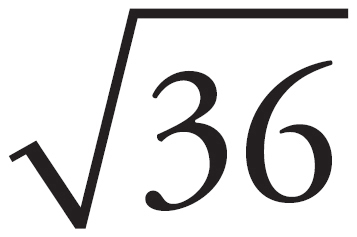 = 6. Also note that this is a Pythagorean triple with sides of 6, 8, and 10.
= 6. Also note that this is a Pythagorean triple with sides of 6, 8, and 10.
3. C
The phrase double the volume of the ant farm means your equation must contain the expression 2V, so eliminate (A), (B), and (E). The second sentence also says that the number of ants is close to 50 more, so your expression will have to contain the expression 2V + 50; (C) is correct because it adds 50. Choice (D) is incorrect because, when the 2 is distributed, it becomes 2V + 100.
4. J
The probability that Lisa will take a fiction book can be defined as a fraction: The number of fiction books divided by the total number of books. Therefore, the probability of Lisa taking a fiction book is 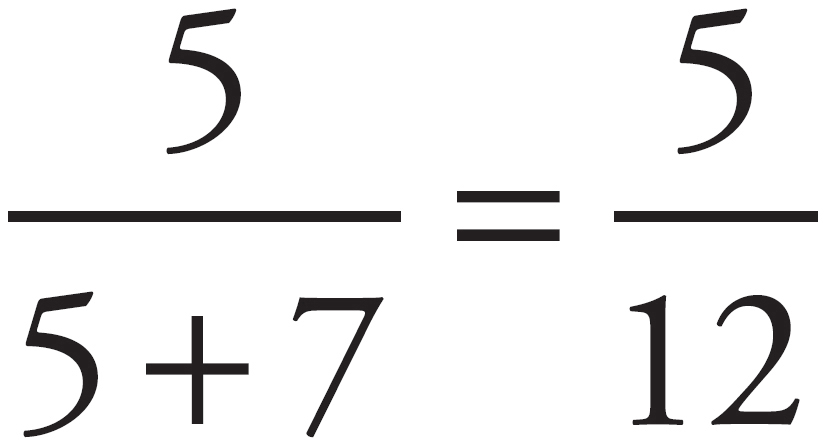 , (J). Choice (K) is the probability that she will take a nonfiction book; (G) is the ratio of fiction books to nonfiction books.
, (J). Choice (K) is the probability that she will take a nonfiction book; (G) is the ratio of fiction books to nonfiction books.
5. C
To find the average, add up all the test scores and divide by the number of tests:  , choice (C). You can eliminate (A) and (B) because the average must be less than the highest test score.
, choice (C). You can eliminate (A) and (B) because the average must be less than the highest test score.
6. K
Angles 3 and 5 are alternate interior angles and therefore congruent. Angles 1 and 3 look congruent only because the triangle appears to be isosceles—the problem does not give any indication that it is, so eliminate (G).
7. A
If p is Gregor’s monthly pay, write an equation that represents Gregor’s deposit. He spends 20% and deposits the rest, so p − (0.2)p = 3,200 or (0.8)p = 3,200. Divide through by the (0.8) to find that p = 4,000. If you’re not sure how to set up the equation, you could also try out the answer choices as possibilities for Gregor’s monthly pay to see which gives a deposit value of $3,200.
8. K
By definition, similar polygons have equal corresponding angles, making (K) the correct response. Two similar polygons are really the same figure on different scales: smaller or larger versions of each other. Therefore, their dimensions are not necessarily the same, making (F), (G), (H), and (J) incorrect.
9. E
Work through this word problem one step at a time. $60 × 0.30 = $18, so the dress is discounted $18. $60 − $18 = $42, the sale price. Now calculate Victoria’s second discount: $42 × 0.10 = $4.20. $42 − $4.20 = $37.80, the price Victoria pays. Choice (D) incorrectly discounts the dress 40%; this is wrong because Victoria gets 10% off the reduced price, not the original price.
10. J
Erin begins with x chips, which means (according to the second sentence of the question) Amy has x − 3. When Erin wins 4 of Amy’s chips, Erin’s total increases to x + 4, while Amy’s drops to x − 7. Subtract (x + 4) − (x − 7) = 11, the difference in their chip totals.
11. C
Since absolute value must always be greater than or equal to zero, you can eliminate (A) and (B). Substitute y = 4 into the expression |1 − y| = |1 − 4| = |−3| = 3.
12. K
FOIL: multiply the First terms 3a × a = 3a2, the Outer terms 3a × (− b2) = (−3ab2), the Inner terms 2b × a = 2ab, and the Last terms 2b × (−b2) = −2b3. Add these terms to get 3a2 − 3ab2 + 2ab − 2b3, (K).
13. D
Simplify the expression: 3 − 2(4 − y) = 3 − 8 + 2y = −5 + 2y, which is the same as (D). Be careful when you multiply two negative values, such as (−2) × (−y): you should get a positive value.
14. G
When raising a number with an exponent to another power, you multiply the exponents; therefore, (y3)8 = y3×8 = y24.
15. A
Sketch out a little calendar until you see a pattern: Day 1 is Monday, 2 is Tuesday, 3 Wednesday, 4 Thursday, 5 Friday, 6 Saturday, 7 Sunday, 8 Monday, and so on. Notice that Sundays are always multiples of 7. Pick a multiple of 7 close to 260, such as 259. That means Day 259 is a Sunday, so Day 260 is a Monday.
16. H
Draw a figure to see the relationship between the two shapes. Since the formula for area of a square is A = s2 (where s is the side length of the square), you can find that a square with area 64 has side length 8, which would also be the diameter of the circle inscribed in this square, meaning the circle’s radius would be 4. The formula for the area of a circle is A = πr2, so A = π(4)2 = 16π.
17. A
Factor x2 − 5x − 14 = 0 to (x − 7)(x + 2) = 0; therefore, the solutions (the values of x that make this true) are 7 and −2. Their product: 7 × −2 = −14. Also, note than in the standard formula ax2 + bx + c, the product of the solutions will always be 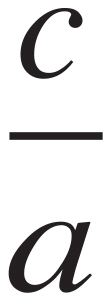 .
.
18. K
Factor x12 − 9 to (x6 − 3)(x6 + 3); eliminate (F) and (G). Factor (x6 − 3) to (x3 − 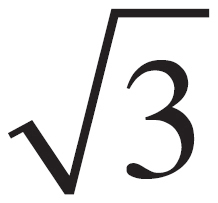 )(x3 +
)(x3 +  ); eliminate (H) and (J).
); eliminate (H) and (J).
19. C
Plug x =  into the expression:
into the expression:  .
.
20. H
Use the formula Distance = Rate × Time. Substitute the values from the problem: 60 = 90 × t. Therefore, t = 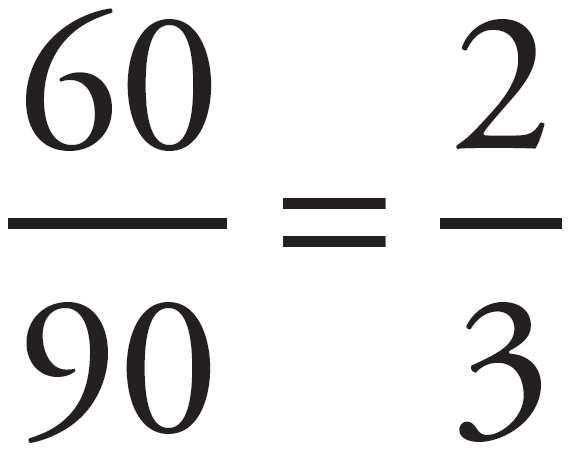 hours. To convert from hours into minutes, multiply 60 minutes by
hours. To convert from hours into minutes, multiply 60 minutes by  hours: 60 ×
hours: 60 ×  = 40 minutes.
= 40 minutes.
21. C
Begin by drawing a perpendicular height by drawing vertical lines from the top vertices straight down to the base: These segments are the height of the trapezoid, and your figure should now look like a rectangle and two right triangles. Since the bottom base of the trapezoid is 11″ and the top base is 5″, the difference is 6″. Assume the two triangles you’ve created are the same size, which means the base of each is 3″ (and the base of your rectangle is 5″). Use the Pythagorean theorem (a2 + b2 = c2) to find the height (which we’ll call h) of one of the triangles: h2 + 32 = (3 )2, so h2 + 9 = 18, h2 = 9, and h = 3. This is also the height of the trapezoid, so plug these values (height and two bases) into the formula in the question:
)2, so h2 + 9 = 18, h2 = 9, and h = 3. This is also the height of the trapezoid, so plug these values (height and two bases) into the formula in the question:  = 3(8) = 24. If you hadn’t been given the formula for the area of a trapezoid, or if you just find the formula too confusing, notice that the vertical heights split this figure into three familiar shapes: two triangles and a rectangle. You can find the area of each of these smaller pieces and add them together.
= 3(8) = 24. If you hadn’t been given the formula for the area of a trapezoid, or if you just find the formula too confusing, notice that the vertical heights split this figure into three familiar shapes: two triangles and a rectangle. You can find the area of each of these smaller pieces and add them together.
22. F
By definition, the roots of a quadratic equation are the values for the variable that cause the equation to equal zero. Starting with the first answer choice, set each factor equal to zero and solve for x: 3x + 2 = 0 yields x = − , and 4x ‒ 1 = 0 yields x =
, and 4x ‒ 1 = 0 yields x =  . None of the other answer choices yields both roots given in the problem.
. None of the other answer choices yields both roots given in the problem.
23. C
Draw the line segments AC and BD; these are the diagonals. By definition, the diagonals of a rhombus bisect each other; therefore, the two halves of AC are 3 each and the two halves of BD are 4 each. The diagonals of a rhombus also (by definition) are perpendicular; this means that each of the four triangles inside this rhombus are right triangles. Use the Pythagorean theorem to find the length of the side of the rhombus: 32 + 42 = s2, so 9 + 16 = s2, 25 = s2, and 5 = s. Note that these sides create a 3-4-5 Pythagorean triple.
24. G
Underline the question and work the problem in bite-sized pieces. PITA (Plug In The Answers) is a good option. Start with choice (H). If the length is 16, the width is 14. The formula for area of a rectangle is, and the area with these dimensions would be 224, far bigger than the 80 the question provides. Eliminate (H), (J), and (K), and try (G). If the length is 10, the width is 8, and the area is 80. Choice (F) is the width and is therefore a possible trap answer.
25. E
Don’t be intimidated by the Cartesian plane: It’s the same (x, y) coordinate plane you’re used to. Slope is defined as 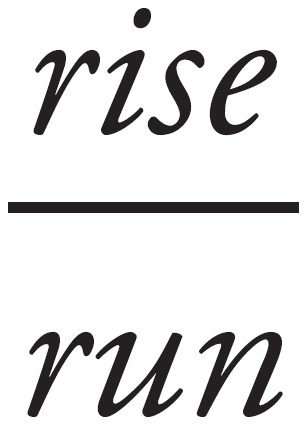 , so use the two points given in the slope formula:
, so use the two points given in the slope formula:

26. G
The equation of a circle is (x − h)2 + (y − k)2 = r2, where (h, k) is the center of the circle, and is the radius. The first part of the equation tells you that the x-coordinate of the center is −5, since (x + 5)2 = (x − [−5])2, so h = −5. The second part more clearly matches the formula, so it’s easier to see that the y-coordinate of the center is 5. Therefore, the center of the circle is (−5, 5).
27. D
The domain of a function is the set of all possible x-values for which the function is defined. The open circles at x = 0 and x = 4 mean that x ≠ 0 and x ≠ 4 ; therefore, eliminate (A), (B), and (E). The solid line between x = 0 and x = 4 means that x can be any value between 0 and 4, so eliminate (C). Make sure you read the question carefully. If you selected (C), you may have mistaken it for the range.
28. F
The point exactly halfway between is another way to describe the midpoint, so plug the two points into the midpoint formula: 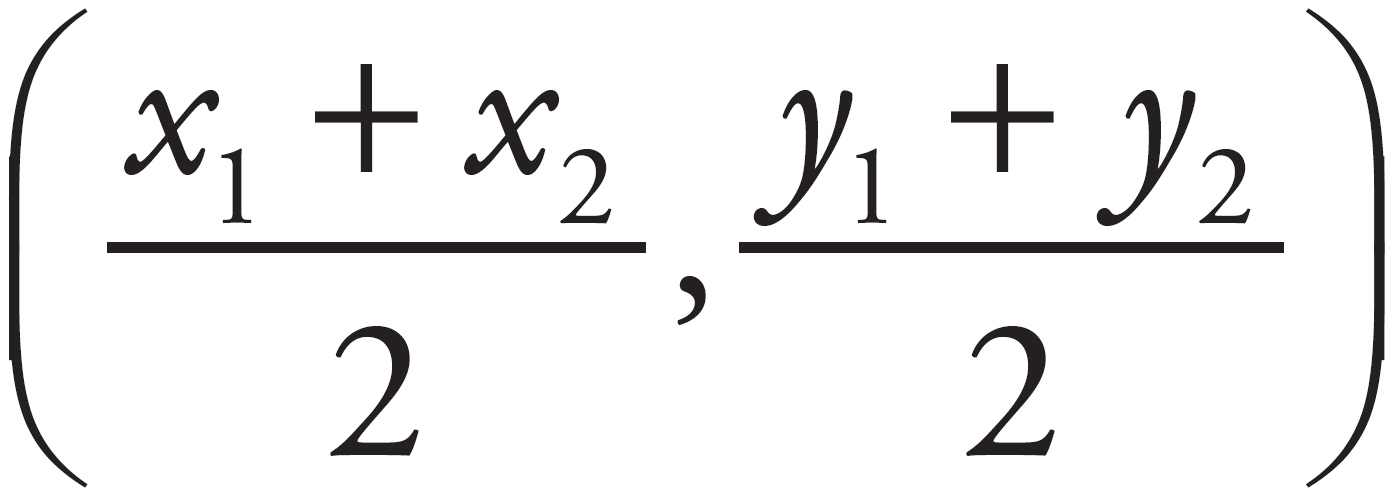 . This gives you
. This gives you 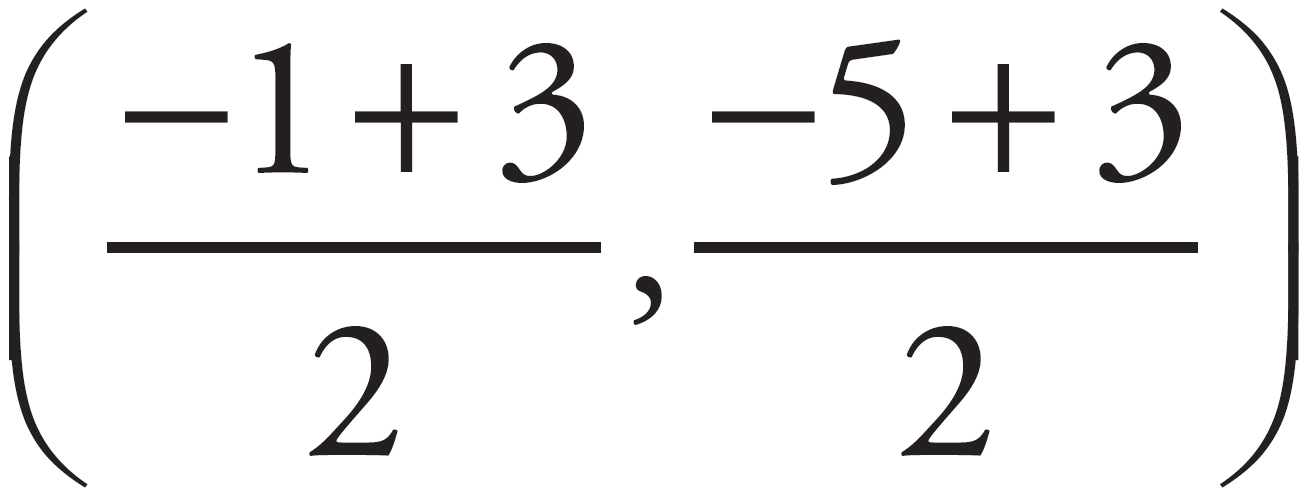 , which simplifies to
, which simplifies to  , or (1,−1).
, or (1,−1).
29. C
To find the average rate of change, begin by finding the total change: the liquid begins at 0° and eventually reaches 80°, so the total change is the difference, 80°. The question asks for the rate of change during the times in which Sanjay is applying heat to the container. Sanjay applies heat from minutes 0 to 5, 7 to 10, and 15 to 17
to 10, and 15 to 17 . Find the difference in each of these pairs of numbers to see that Sanjay applied heat for 5 minutes, then 2.5 minutes, then another 2.5 minutes, or 10 minutes total. Therefore, the average rate of change in degrees per minute is
. Find the difference in each of these pairs of numbers to see that Sanjay applied heat for 5 minutes, then 2.5 minutes, then another 2.5 minutes, or 10 minutes total. Therefore, the average rate of change in degrees per minute is  = 8 degrees/min.
= 8 degrees/min.
30. H
When you divide exponentials with the same base, you subtract the exponents, so  = ax−y; therefore, ax−y = a5 and x − y = 5.
= ax−y; therefore, ax−y = a5 and x − y = 5.
31. E
Rearrange the equation into slope-intercept form (y = mx + b). 8 − 3y = 5x becomes 3y = 5x + 8, or y = 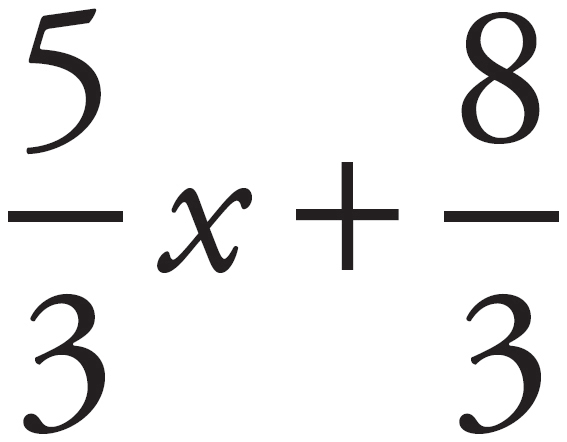 . In slope-intercept form, m is the slope; in this case,
. In slope-intercept form, m is the slope; in this case,  .
.
32. J
The least common denominator (LCD) must be a multiple of the denominator of each of the three given fractions. Take the factors of each denominator (3, 5, 7, 11) to the highest powers they appear: 32 (first fraction), 52 (second fraction), 7 (second fraction), and 113 (third fraction). This results in 32 × 52 × 7 × 113, choice (J). Choice (K) is the product of all three denominators and is wrong because choice (J) is smaller and still a multiple of all three denominators; in other words, both are common denominators but (J) is the “least.”
33. C
To multiply fractions, you multiply all the numbers on top of the fractions and all the numbers on the bottom of the fractions:  =
=  . Now, before you pull out the calculator, you can cancel out numbers that appear on both the top and bottom (4, 5, 6, and 7) because a number divided by itself (such as
. Now, before you pull out the calculator, you can cancel out numbers that appear on both the top and bottom (4, 5, 6, and 7) because a number divided by itself (such as  ) is 1, which doesn’t affect the final product. After canceling, you get
) is 1, which doesn’t affect the final product. After canceling, you get 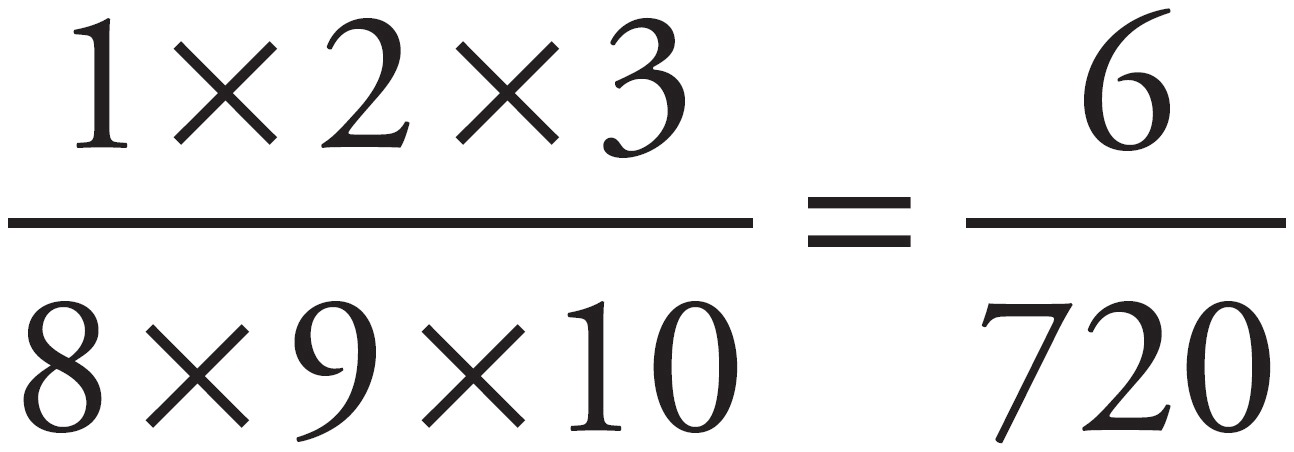 , which reduces to
, which reduces to  .
.
34. K
The figure provided is a right triangle, so use the Pythagorean theorem (a2 + b2 = c2) to find the distance asked for. 1102 + 2002 = c2, so 12,100 + 40,000 = c2, 52,100 = c2, and 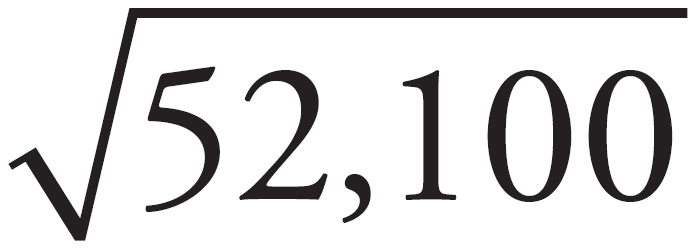 = c.
= c.
35. E
The key phrase in this question is at most. It’s possible that the second pentagon is the same size and is laid directly over the original pentagon. Because all points of one pentagon are the same as the other, select (E).
36. K
When assigning employees to duties, there are 10 available to reserve a venue (the first duty). That leaves 9 remaining to arrange catering (because no one can be assigned more than one duty) and then 8 to plan activities. Then multiply 10 × 9 × 8 to find how many different ways these duties can be assigned. Note the format of the answer choices—don’t do more work than you have to.
37. E
The easiest way to work this problem is to sketch it out. Draw PQ, then draw the line perpendicular to PQ at Q; R is somewhere on this line. All of the answer choices have x-values greater than 1 and you can see the line rising to the right of Q (1, 4) in your sketch. This means that the y-value of R must be greater than 4, which leaves only (E). Alternatively, you could find the slope of PQ: The slope formula is 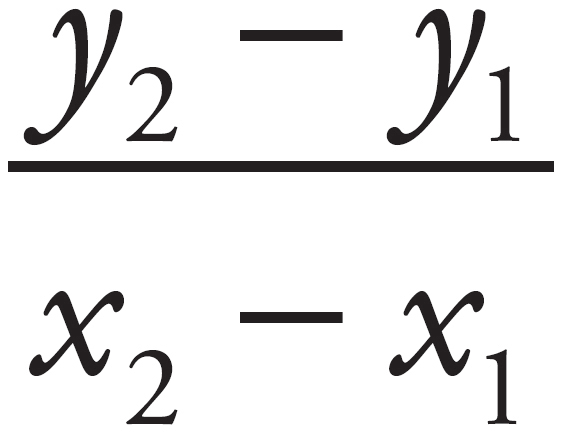 , so
, so 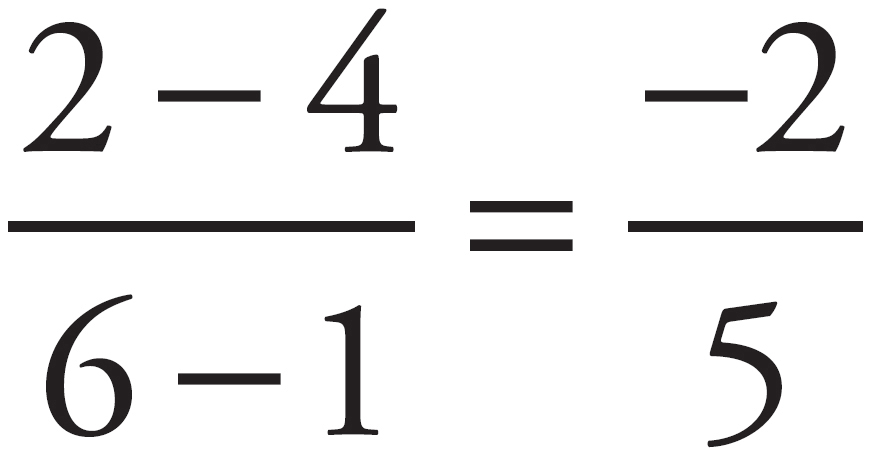 . Since ∠PQR is a right angle, PQ ⊥ QR. In the coordinate plane, the slopes of perpendicular lines are negative reciprocals, so the slope of QR is
. Since ∠PQR is a right angle, PQ ⊥ QR. In the coordinate plane, the slopes of perpendicular lines are negative reciprocals, so the slope of QR is  . Then use the points given in each answer choice to see which gives you the correct slope. It’s (E):
. Then use the points given in each answer choice to see which gives you the correct slope. It’s (E): 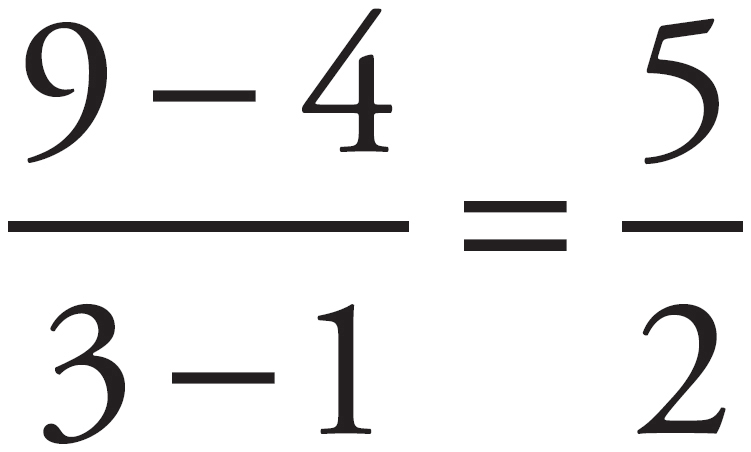 .
.
38. J
Solve the given equation for y. Start with y = 0.25(100 − y). You can either distribute the 0.25 or divide both sides by the 0.25. In this case, it is easier to divide by 0.25. After doing this your equation becomes: 4y = 100 − y. Add y to both sides to get 5y = 100. Divide both sides by 5 to get y = 20. If you chose to begin the problem by distributing the 0.25, you should have gotten the same answer.
39. B
Since 4cos2x = 1, cos2x = 0.25 and cosx = 0.5. You want to know x, the degree measure whose cosine is 0.5. A scientific/graphing calculator can help you calculate that: the cos−1 key will tell you the degree measure that yields the cosine you give it. cos−1(0.5) = 60°, so (B) is correct. If you prefer, you can try each of the answers in your scientific/graphing calculator. When you plug in (B), you can find that cos60° = 0.5, so cos260° = 0.25, and 4cos260° = 1. Make sure your calculator is in degree mode!
40. H
Sketch the rug over the floor to help you visualize the situation. The area of the exposed floor is the difference between the area of the entire floor and the area of the rug. First, find the area of the entire floor: area of a rectangle formula is A = lw, so A = 16 × 18 = 288. Area of a circle formula is A = πr2, where r is the radius. The diameter is 12, so r = 6. Therefore, A = π × 62 = π × 36, which is approximately 113. Calculate the difference: 288 − 113 = 175. If you got a negative number when you did the calculation, you may have used the diameter of the circle in the area of a circle formula rather than the radius.
41. E
To tackle this question, begin by ballparking out (A), (B), and (C), as these intervals contain areas where the parabola is decreasing, not increasing, and the question is asking for the greatest rate of change. To compare the remaining answer choices, find the change in y-values over the change in x-values. From x = 10 to x = 13, the change in y-values is 39 − 12 = 27, and the change in x-values is 13 − 10 = 3. The rate of change is then 27 over 3, or 9. From x = 13 to x = 14, the change in y-values is 52 − 39 = 13, and the change in x-values is 14 − 13 = 1. The rate of change is then 13 over 1, or 13. As the rate of change is greater for x-values from 13 to 14 than it is from 10 to 13, (E) is the correct answer.
42. F
Draw a vertical line from the point (2 , 2) straight down to the x-axis; this creates a right triangle with base 2
, 2) straight down to the x-axis; this creates a right triangle with base 2 and height 2. Use the Pythagorean theorem (a2 + b2 = c2) to find the hypotenuse: (2
and height 2. Use the Pythagorean theorem (a2 + b2 = c2) to find the hypotenuse: (2 )2 + 22 = c2, so 4 × 3 + 4 = c2, 12 + 4 = c2, 16 = c2, so 4 = c. (A shortcut is to recognize that this is a 30°-60°-90° triangle. Such a triangle has a ratio of side lengths 1:
)2 + 22 = c2, so 4 × 3 + 4 = c2, 12 + 4 = c2, 16 = c2, so 4 = c. (A shortcut is to recognize that this is a 30°-60°-90° triangle. Such a triangle has a ratio of side lengths 1:  :2, which means this triangle’s sides are 2, 2
:2, which means this triangle’s sides are 2, 2 , and 4.) Since sine is the ratio of the opposite side to the hypotenuse, sin θ =
, and 4.) Since sine is the ratio of the opposite side to the hypotenuse, sin θ =  =
=  .
.
43. C
The question provides a relationship between the variables, so Plugging In is the safest way to go. Use numbers that will make the math as straightforward as possible, as long as the value for A is 3,000 times the value of A0. Plugging A = 3,000 and A0 = 1 in to the function yields R = 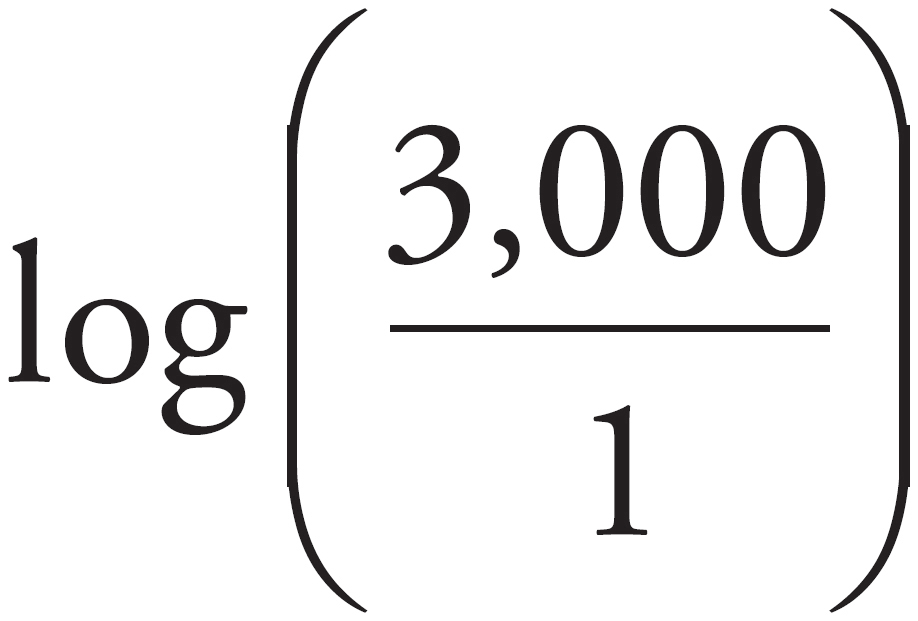 . Typing this into the calculator results in approximately 3.47712, which is closest to 3.5.
. Typing this into the calculator results in approximately 3.47712, which is closest to 3.5.
44. G
Probability is defined as 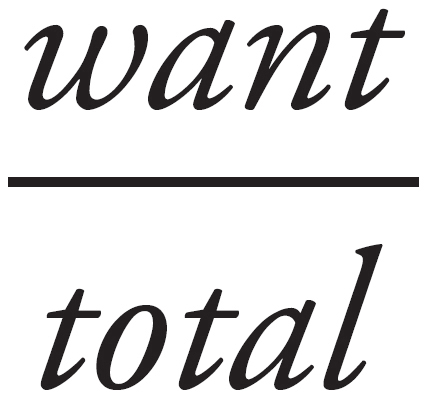 . Since there are four elements in set P and four elements in set Q, the total number of possible outcomes is 4 × 4 = 16. The numerator is restricted to include only products of m and n that are even. The first element in set P is 2, which is already even, so multiplying that by any of the four elements from set Q will remain even, which produces four possibilities. The same will hold true for the fourth element in set P, 6. This would result in another four possibilities. At this point you can eliminate (J) and (K) because they are too low. Since 3 is an odd number, it must be multiplied by an even number to produce an even integer, so 3 × 2 = 6 and 3 × 4 = 12 are the only two possibilities using 3 from set P. Eliminate (H) since you now have 10 possible scenarios. Finally, check the possible results using 5.5 from set P: 5.5 × 1 = 5.5, 5.5 × 2 = 11, 5.5 × 3 = 16.5, and 5.5 × 4 = 22. Only one of those outcomes is even. There are 11 outcomes that are even, out of a total 16 possible outcomes. This results in a probability of
. Since there are four elements in set P and four elements in set Q, the total number of possible outcomes is 4 × 4 = 16. The numerator is restricted to include only products of m and n that are even. The first element in set P is 2, which is already even, so multiplying that by any of the four elements from set Q will remain even, which produces four possibilities. The same will hold true for the fourth element in set P, 6. This would result in another four possibilities. At this point you can eliminate (J) and (K) because they are too low. Since 3 is an odd number, it must be multiplied by an even number to produce an even integer, so 3 × 2 = 6 and 3 × 4 = 12 are the only two possibilities using 3 from set P. Eliminate (H) since you now have 10 possible scenarios. Finally, check the possible results using 5.5 from set P: 5.5 × 1 = 5.5, 5.5 × 2 = 11, 5.5 × 3 = 16.5, and 5.5 × 4 = 22. Only one of those outcomes is even. There are 11 outcomes that are even, out of a total 16 possible outcomes. This results in a probability of 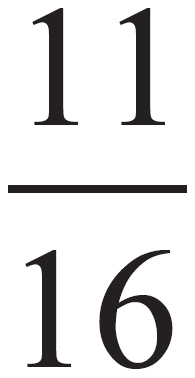 .
.
45. B
Because the statement includes an absolute value, you’ll need to solve it twice: once assuming the expression inside is positive, once assuming it’s negative. First, the positive assumption: 2z − 3 ≥ 7, so 2z ≥ 10 and z ≥ 5. Eliminate (C), (D), and (E). Now, assume the expression is negative: you’d multiply a negative number by −1 to make it positive, so −(2z − 3) ≥ 7. Solve by multiplying both sides by −1 (remember to flip the sign): 2z − 3 ≤ −7, so 2z ≤ −4 and z ≤ −2. Eliminate (A). Alternatively, you could try substituting in values for z. Try z = 4: |2 × 4 − 3| = |8 − 3| = |5| = 5. This expression is supposed to be ≥ 7; since it isn’t, you can eliminate any answer choices that include z = 4, so eliminate (C), (D), and (E). Try z = −3: |2 × (−3) − 3| = |−6 −3| = |−9| = 9. This is ≥ 7, so z could be equal to −3; therefore, eliminate (A).
46. H
To simplify this expression, recall the identity tan x = 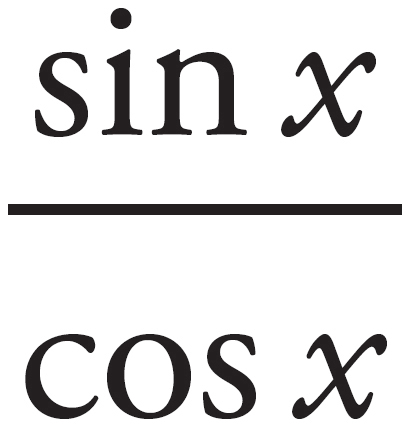 . Now
. Now 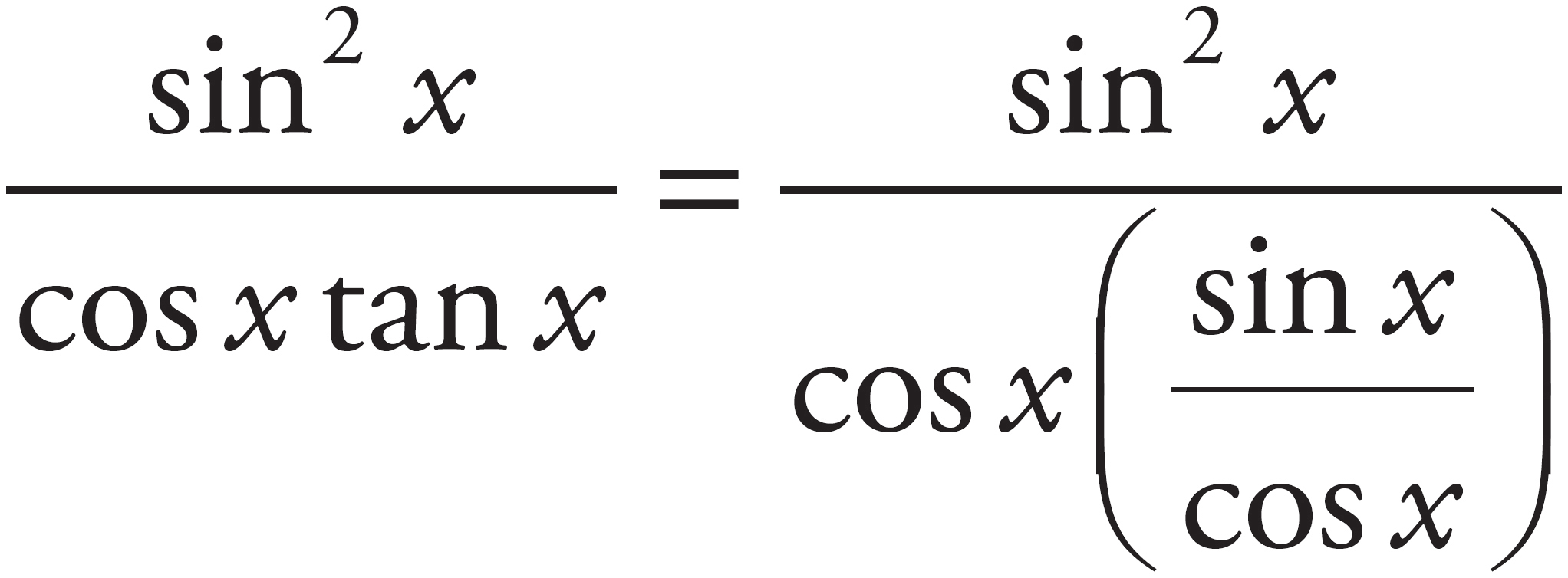 . Simplify:
. Simplify: 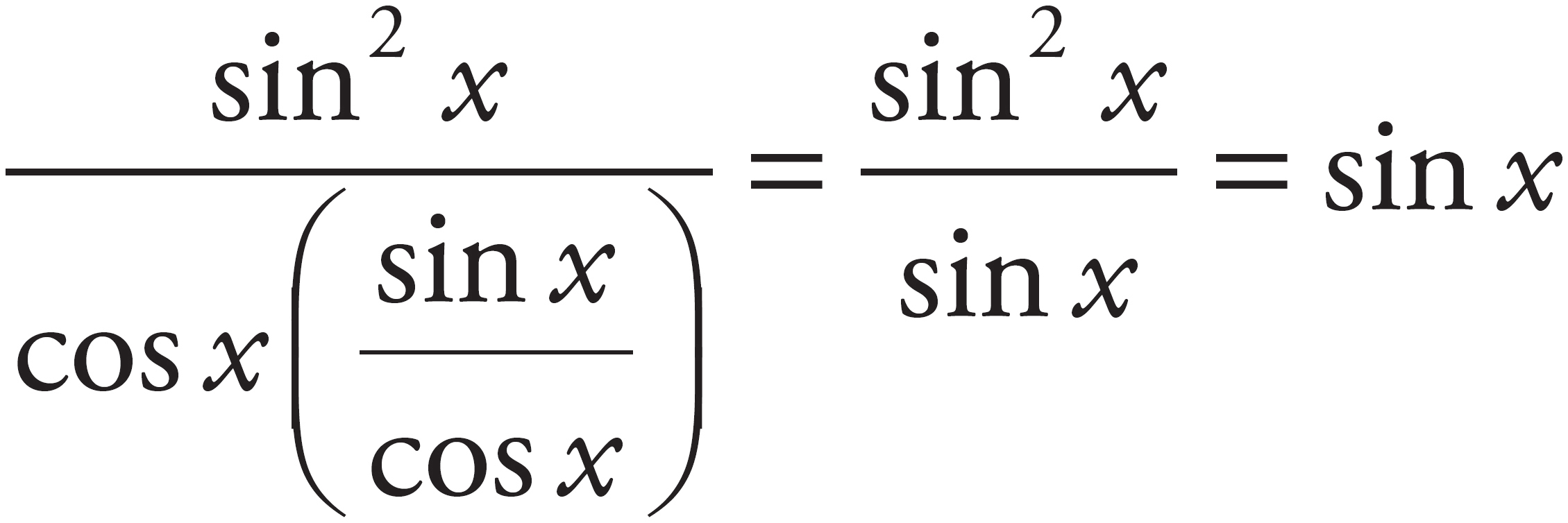 .
.
47. D
Try plugging the values of x given into the answer choices in the expression. Try x = −4:  . Since
. Since  , simplifies to −1. Since −1 < 0, x = −4 is valid: eliminate (B), (C), and (E). Now try x = −
, simplifies to −1. Since −1 < 0, x = −4 is valid: eliminate (B), (C), and (E). Now try x = − :
:  =
=  . This is also less than 0, so eliminate (A).
. This is also less than 0, so eliminate (A).
48. J
The original volume of the figure is described by the equation V =  πr2h. The new cylinder has had its radius halved and its height doubled, so the volume of the new cylinder will be
πr2h. The new cylinder has had its radius halved and its height doubled, so the volume of the new cylinder will be  . This volume is then one-half of the earlier volume, and the ratio is 1:2. If you selected (H), be careful—you may have forgotten to square the new radius value.
. This volume is then one-half of the earlier volume, and the ratio is 1:2. If you selected (H), be careful—you may have forgotten to square the new radius value.
49. B
Al’s biking time going up the hill was m minutes, and because he went down the hill twice as fast, his time going down was  m. His total time going up and down the hill was therefore m +
m. His total time going up and down the hill was therefore m +  m or
m or  m. If you pick (D), be careful—you’re not done here! The variable m represents the time in minutes, and the question asks for the time in hours; therefore, you need to divide the total value by 60:
m. If you pick (D), be careful—you’re not done here! The variable m represents the time in minutes, and the question asks for the time in hours; therefore, you need to divide the total value by 60:  .
.
50. G
Begin by noticing the answer choices are not simplified, which means unnecessary calculations can be avoided. The geometry basic approach is to first write down formulas and plug in what is known. The volume of a cylinder is expressed as V = πr2h, and the volume of a cube is V = s3, where s is the length of the side. According to the structure of the answer choices, the volume of the cube will need to be subtracted from the volume of the cylinder. Use bite-sized pieces and start with the cube. The side is a length of 3 centimeters, so the volume equals 33. Choices (H) and (J) can be eliminated. With the cylinder, the radius is 5 and will need to be squared, so (F) and (K) can be eliminated.
51. D
Draw a horizontal line, which is also the radius of the circle, from the center of the circle to the right side of the square: this creates a 45°-45°-90° triangle. Recall that the ratio of sides in this type of triangle is s:s:s  . To find the length of the sides, and hence the radius, divide the hypotenuse (x) by
. To find the length of the sides, and hence the radius, divide the hypotenuse (x) by  , giving
, giving 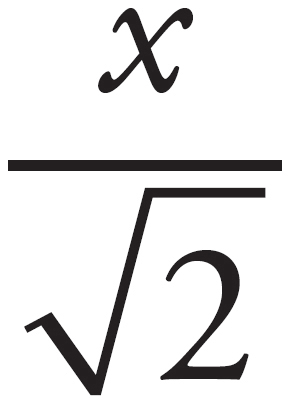 , which, after multiplying by
, which, after multiplying by 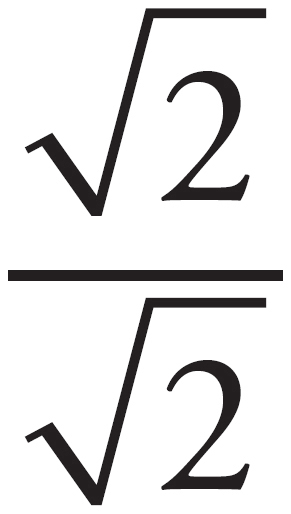 to rationalize the denominator, becomes
to rationalize the denominator, becomes  , (D). You just found the radius, so (E) is wrong.
, (D). You just found the radius, so (E) is wrong.
52. K
To multiply two matrices together, multiply the values in each row of the first matrix by those in each column of the second matrix and add the products together. There is no need to multiply everything out, as the question only asks for the value of a in the first row of the first matrix. Use the value in the upper left of the matrix on the right of the equation, 35, to determine what value of a would result in 35. The equation becomes (4a × 2) + (3 × 4) + (−1 × 1) = 35. Simplify within the parentheses to get 8a + 12 − 1 = 35, which becomes 8a + 11 = 35. Subtract 11 from both sides to get 8a = 24, so a = 3.
53. C
Each of the smaller pipes can handle exactly half as much water as the large pipe means that the area of the cross-section of the small pipe is one-half the area of the cross-section of the large pipe. So start by finding the area of the circular cross-section of the large pipe: A = πr2, so A = π(4)2 = 16π. Therefore, the area of the cross-section of the smaller pipe is one-half that, or 8π. So for the smaller pipe’s circular area 8π = πr2, 8 = r2, and r = 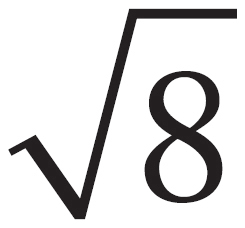 =
=  ×
×  = 2
= 2 .
.
54. H
The height (which we’ll call h) divides this figure into two right triangles, each with base length of 3 feet. Tangent is the ratio of the opposite side to the adjacent side, so tan 40° =  . Solve for h by multiplying both sides by h: h(tan40°) = 3, so
. Solve for h by multiplying both sides by h: h(tan40°) = 3, so 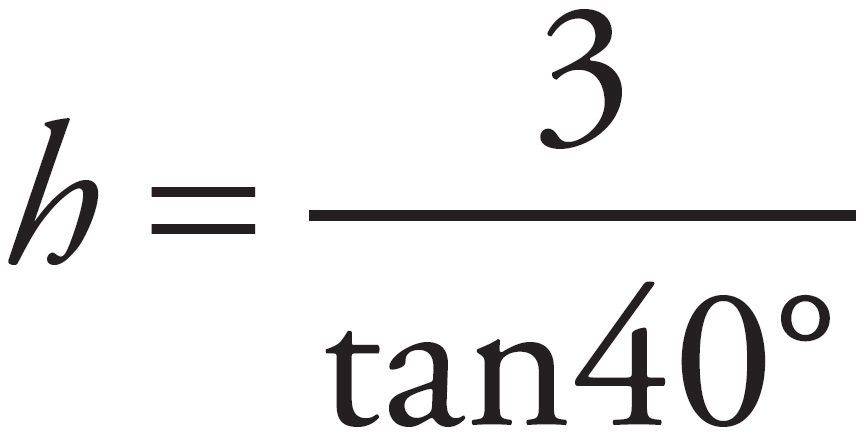 .
.
55. D
Standard deviation is the measure of the spread of data. To find the data set with the lowest standard deviation, look for the points that are closest together. Choice (A) has points spread apart in increments of 5. Choice (B) has points spread apart by increments of 100, so (B) can be eliminated as those increments are greater than those of (A). Choice (C) contains points spread apart by increments of 2, so now (A) can be eliminated. Choice (D), though consisting of larger numbers, has elements grouped more closely together than the elements in (C), so eliminate (C). Choice (E) contains points spread apart by increments of 1 continually, which is further spread apart than the elements in (D), so (E) can be eliminated.
56. G
If a is a positive integer and b is a negative integer, the only answer choice that will never yield a negative exponent (and therefore a fraction) is (G). If you’re unsure, try substituting values for a and b. Let’s say a = 2 and b = −3. Choice (F) becomes 32–3 = 3−1 =  ; that’s not an integer, so you can eliminate (F). Likewise, for (H), 32(−3) = 3−6 =
; that’s not an integer, so you can eliminate (F). Likewise, for (H), 32(−3) = 3−6 = 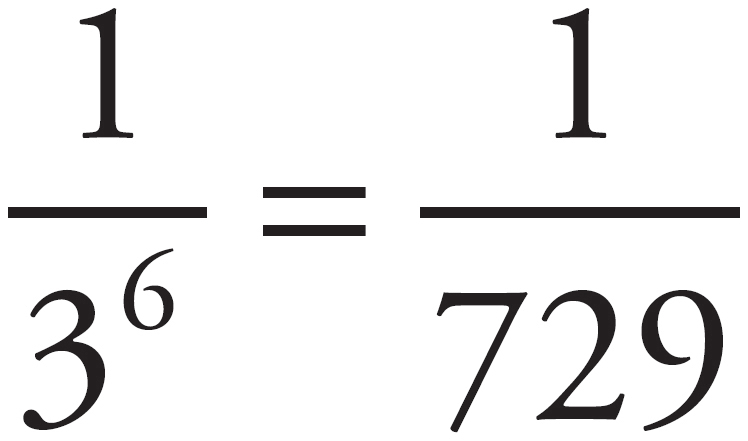 , (J), 3−2 =
, (J), 3−2 = 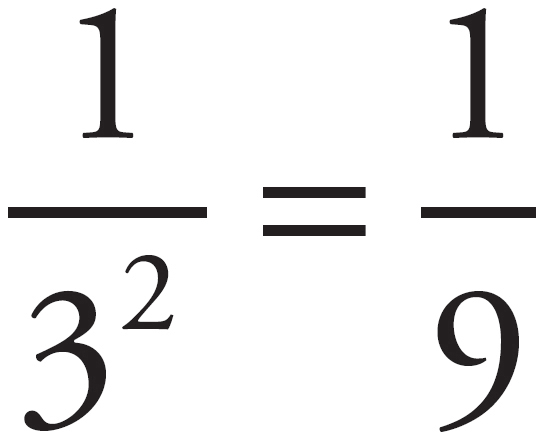 , and (K),
, and (K), 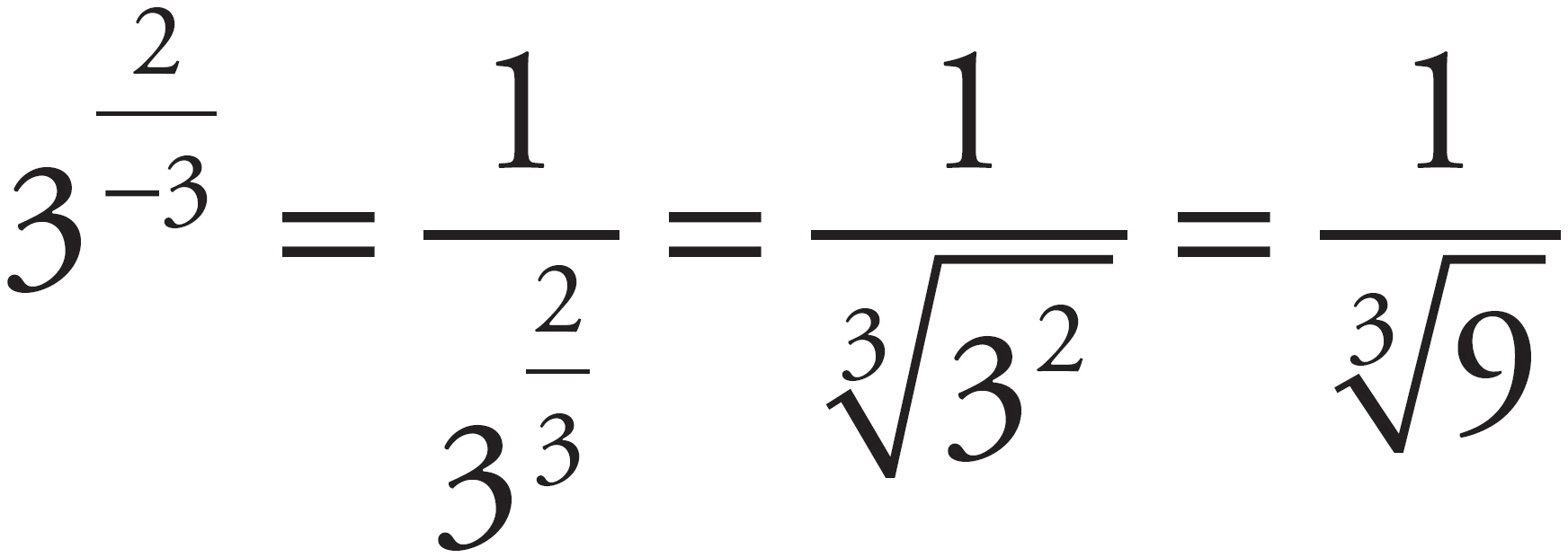 . Only (G) gives you an integer: 32−(−3) = 32+3 = 35 = 243.
. Only (G) gives you an integer: 32−(−3) = 32+3 = 35 = 243.
57. A
The question tells you that 0 < 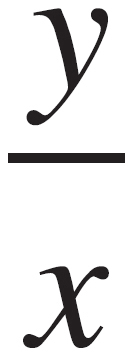 , which means
, which means  ≠ 0, so eliminate (D) and (E). The only way
≠ 0, so eliminate (D) and (E). The only way  could be larger than y itself is if x < 1 and y ≥ 1. In other words, y could be 1 in this situation, and since we are told that
could be larger than y itself is if x < 1 and y ≥ 1. In other words, y could be 1 in this situation, and since we are told that  > y,
> y,  must be greater than 1. This is a tough problem, and if you’re not sure how to come up with these relationships, try to find numbers that make the initial relationship true and try them out on the number line. If x = 0.5 and y = 1, then
must be greater than 1. This is a tough problem, and if you’re not sure how to come up with these relationships, try to find numbers that make the initial relationship true and try them out on the number line. If x = 0.5 and y = 1, then  = 2, for example, so you can eliminate (C) [and (D) and (E), which you’ve already eliminated]. You’ll find that you can’t get a number less than 1 for
= 2, for example, so you can eliminate (C) [and (D) and (E), which you’ve already eliminated]. You’ll find that you can’t get a number less than 1 for  .
.
58. F
Sketch out the rectangular 100 feet by 150 feet field described in the question. The 10 foot border within the field creates a new, smaller rectangle, 80 feet by 130 feet. The largest circle that can fit in this rectangle has a diameter of 80 feet, so it has a radius of 40 feet. If you picked (G), be careful—you may have forgotten to subtract 10 feet on both sides of the track.
59. D
Imagine cutting an orange: The first slice (one plane) cuts it into two pieces. If you hold those two pieces together and make another slice (the second plane), you cut both of those pieces, thereby creating 4 sections. Eliminate (A) and (C). Now, if you repeat this orange-slicing experiment, but your second slice is parallel to the first slice, it cuts a circular slice off only one piece, thereby creating 3 sections, so eliminate (B). The only way to keep the orange in two pieces after the first slice is for the second slice to repeat the first exactly. Since the question said the sphere was to be cut by two different planes, this cannot happen; therefore, it’s impossible to get only 2 pieces, so eliminate (E).
60. K
“Positive difference” means that when you subtract a − b you can get +5 or −5. (That’s also what the absolute value indicates.) Solve for a in both cases: a − b = 5, so a = b + 5; and a − b = −5, so a = b − 5. Now subtract these two values: (b + 5) − (b − 5) = b + 5 − b + 5 = 10, choice (K). Alternatively, you could substitute a number for b: let’s say b = 2, so |a − 2| = 5. Then solve: a − 2 = 5, so a = 7; and a − 2 = −5, so a = −3. The positive difference is 7 −(−3) = 7 + 3 = 10.
READING TEST
1. C
This question asks for a shift found in the last paragraph. While the majority of the passage describes a memorable and mostly positive event in the narrator’s life, the last paragraph finds the narrator apologizing for his actions and starting to understand that his expectations had been unrealistic. Eliminate (A), as the passage begins with the end of segregation in baseball. While the narrator does blame his outburst on his fever, he admits it’s only partly true, so eliminate (B). And while the narrator’s grandfather’s anticipation is mentioned early, anger doesn’t fit the grandfather’s tone in the last paragraph, so eliminate (D). Choice (C) is the correct answer.
2. F
The narrator describes Robinson as a gentleman, who never los[es] his cool. As well, he mentions that he is proud that Robinson is playing. Eliminate (G); though he initially thinks Robinson is capable of doing the impossible, the question asks how he ultimately sees Robinson. While the narrator is at one point disappointed in a play, he learns that what matters is how he plays the whole game, so eliminate (H). And (J) could describe the narrator and/or his grandfather, but the question asks about Robinson, so eliminate (J). Choice (F) is the correct answer.
3. A
The narrator lets out the groan directly after Robinson gets an out and later apologizes to his grandfather, who tells the narrator that Robinson needs [their] support. This contradicts answer (B), so eliminate it. There is no indication that the grandfather is overly concerned with his ability to concentrate on the game, so eliminate (C). Choice (D) is too literal and doesn’t consider the grandfather’s response to the narrator’s apology. Choice (A) is the correct answer.
4. G
This passage shows the point of view of a man who was in attendance at Jackie Robinson first game, and the question asks about the narrator’s description of inside the stadium. Both (F) and (H) are too broad, and the positive description here does not align with the future distress the narrator feels, so (J) is out as well, leaving (G) as the correct answer.
5. B
This question is most easily worked in two parts; first figure out if the effect was different or similar, use POE to get rid of half the answers, and then eliminate based on the latter half of the remaining answers. In the second paragraph, the narrator tells how my friends and I were flying high as we left the stadium. Later, as he recounts the death of Martin Luther King, Jr., he describes those earlier sentiments as hopelessly naïve. This indicates that the effect was different than anticipated, so eliminate (C) and (D). Eliminate (A) as the size of the crowd is not related to the effect on segregation, while (B) aligns closely with the narrator’s statement: change, we thought, was rapidly coming.
6. H
As the narrator talks about the death of Martin Luther King, Jr. in juxtaposition to his attendance at Jackie Robinson’s first major league game, he says at times it felt like nothing had been accomplished in the 21 years. Nothing is said about role models, so eliminate (F). The mention of King does not point to Robinson’s importance in baseball, so eliminate (G), nor does it indicate Robinson’s stretch beyond the world of baseball, so eliminate (J). Choice (H) is the correct answer, as it ties directly to the narrator’s comment about feeling nothing had been accomplished.
7. A
The question asks for a comparison made by the author in the passage. Eliminate (B) as there is no comparison made between golf and major league baseball. The reference to “bed covers” is made only in Passage A, so eliminate (C), and there’s also no mention of “striking out” in Passage B, so eliminate (D). Choice (A) is the correct answer.
8. J
This question asks to compare the tones of the two passages. Passage A starts with excitement but finishes with a bit more of a somber tone, similar to the positivity in the first half of Passage B followed by disappointment in the latter half. Eliminate (F), as “hopeful and cheery” doesn’t describe the progression of Passage A. As Passage A is an anecdote, it wouldn’t be described as “objectively factual” so eliminate (G). Eliminate (H) as it disregards the positive aspects of the passages. The correct answer is (J).
9. B
While Passage A describes the events of only one day, Passage B relays the events of that day along with future events. Eliminate (A), as a play-by-play is not included in either passage. Eliminate (C) since Passage B does not discuss Robinson’s career prior to that day’s events. Eliminate (D) as neither passage discusses the Negro League. Choice (B) is the correct answer.
10. J
While both passages start optimistic and take a turn for the somber, Passage B does so by directly relating the experience to the expectation for a change in racial equality, while Passage A is more focused on what a single character learns. Because of this, eliminate (F). As well, there is no indication of the narrator’s likelihood to stop following the Dodgers, so (G) is out. While the narrator of Passage A does initially feel disappointment that Robinson doesn’t play perfectly, that feeling is superseded by directions from his grandfather to take a cue from the way [Robinson’s] stood up to his critics, an overall positive tone. Eliminate (H), and select (J) as the correct answer.
11. D
This passage describes the formation and activities of the CCC. No one was “forced” to work in the CCC, so you can eliminate (A). The CCC did employ many veterans, but nothing in the passage supports the claim that veterans had suitable employment “only after” the creation of the CCC.
12. G
While (F) is true, it isn’t the main idea of the paragraph. Choice (H) is incorrect because the bonuses were never paid. For (J), the paragraph says that the age restriction was waived, but at no point does it say how many of these veterans were over the age limit. Only (G) gives a reasonable summation of the content of the paragraph.
13. D
The passage states that Roosevelt also cared about the fate of trees, having practiced the art of silviculture on his Hyde Park estate with such enthusiasm that on various official forms he was fond of listing his occupation as ‘tree farmer.’ Choice (A) makes an assumption that is not supported in the passage; there is nothing to suggest that his interest in silviculture predated his political life. Choices (B) and (C) are not supported in the passage. Only (D) is supported by the sentence cited above.
14. G
Read this question carefully. The lines you need are 61–63: For the National Park Service, they built roads, campgrounds, bridges, and recreation and administration facilities. This clearly supports (G). The other activities in the answer choices are mentioned in the passage, but not as things the CCC did for the National Park Service.
15. A
Starting on line 72, the passage reads, the program taught more than a hundred thousand to read and write, passed out twenty-five thousand eighth-grade diplomas and five-thousand high-school diplomas. This line most clearly supports (A). Choices (B) and (D) contain deceptive language from elsewhere in the passage, but they do not describe the CCC. Choice (C) is a trap because of the placement of the word only. As written, (C) means that all men the CCC accepted were those with six teeth.
16. G
Lines 24–25 describe the terms of payment in the CCC, so eliminate (F). Line 58 describes the 4.1 million man-hours spent fighting forest fires; it does NOT say that the CCC employed 4.1 million men, so eliminate (H). The states referred to in (J) are described in the passage as the sites of flood control projects, not firefighting projects. Only (G) has support in the passage.
17. C
Lines 60–61 describe the first major reforestation campaign in the country’s history. Although the specific years during which this reforestation campaign took place are unclear, the campaign must have taken place after the establishment of the CCC in 1933. It can therefore be inferred, because this was the “first,” that the nation had not undergone a major reforestation campaign before, as (C) suggests.
18. F
Lines 11–16 state the following: When he went to Congress for authorization of the program, he called the new agency the Civilian Corps Reforestation Youth Rehabilitation Movement, but before sinking under the weight of an acronym like CCRYRM, it was soon changed to the Civilian Conservation Corps (known forever after as the CCC). These lines describe the change, and only (F) is supported by the time of these events. The only other answer that might work chronologically would be (G), but nothing in the passage supports the claim that Congress complained about the length of the name.
19. C
Lines 29–30 state that the men had to be US citizens between the ages of seventeen and twenty-seven (later twenty-four). Since the question asks about enrollees when the CCC was founded, you can disregard the “later” age; (C) gives the correct age range.
20. G
Lines 21–24 state that the Departments of Agriculture and Interior…would design and supervise projects in regional and national forests, national parks, and other public lands. These lines give direct support to (G), and they show that the others are incorrect or inadequate responses to the question.
21. C
This passage deals with the importance of the totem pole and the role the totem pole plays in Native American culture. Even with this very general overview of the passage, the only answer that fits is (C). The others are too specific or suggest incorrectly that the tone of the passage is negative.
22. G
The question in (F) is answered in lines 2–3. The question in (H) is answered in lines 65–66. The question in (J) is answered in lines 8–9. Only the question posed in (G) goes unanswered in the passage. The discussion in the fourth paragraph is distracting, but notice this paragraph does not claim that the pole in Pioneer Square is the largest.
23. C
Note the opening sentence of the fifth paragraph on line 39: Poles serve the important purpose of recording the lore of a clan, much as a book would. The other choices describe some minor functions of totem poles, but only the function described in (C) is described as important.
24. G
This paragraph describes the meanings of some of the symbols used on totem poles. Choice (F) would be fine if it did not contain the word every. Clearly, a short paragraph cannot describe every possible symbol. There are no regional comparisons, so you can eliminate (H). Choice (J) is too limited. Think in terms of the larger point of this paragraph; it describes figures other than the Raven. Only (G) adequately describes the main idea of the paragraph.
25. D
Choice (A) is addressed in lines 40–41. Choice (B) is addressed just after this in lines 42–44. Choice (C) is addressed in lines 64–66. Choice (D) may seem like it is addressed in the passage, but read this part of the passage carefully. There is no reference to the importance of this pole in Native American culture; after all, the group that took it, according to line 33, were Seattle businessmen, not the Tlingit.
26. J
Choice (F) is addressed in lines 13–15. Choice (G) is addressed in line 12. Choice (H) is addressed in line 17. Choice (J) is not addressed in the passage; the family crest is mentioned in line 16, but there is no evidence in the passage that the poles were constructed exclusively by clans who had family crests.
27. B
As lines 39–41 indicate, one of the main functions of the poles is to identify the lore of a clan. The points referred to in (A), (C), and (D) are mentioned, but none could be described as a “main point.” Only (B) is general enough to be described as a “main point.”
28. J
When the Tlingit are introduced in line 31, they are described as coming from the southeastern coast of Alaska. Only (J) could work. Don’t be distracted by the other places mentioned in this paragraph; those places may have some significance for the Tlingit, but could not be described as the home of the Tlingit.
29. A
This paragraph is used to conclude some of the ideas in the preceding paragraphs and to suggest the broader importance of totem poles beyond their physical beauty. Choices (B), (C), and (D) all use words from the passage, but they use those words in misleading ways. Only (A) can be supported by evidence from the passage.
30. H
All we know about the employers is that they complained that their Indian workers were unreliable when a pole was being carved or a potlatch planned (lines 27–28). Because this is the only reference the author gives to these employers, we can only infer that the employers were irritated, as (H) suggests.
31. C
Lines 14–16 state: …in the present climate of fiscal austerity, there is no telling when humans will next get a good look at the Earth’s nearest planetary neighbor. Choice (A) can be eliminated because the authors are clearly not cheerful and optimistic. Choice (B) can be eliminated because the authors’ tone does not suggest sarcasm or condescension. Choice (D) can be eliminated because of the word withdrawn. Only (C) is supported by the lines quoted above: They are doubtful (there is no telling) and pragmatic (in the present climate of fiscal austerity).
32. H
Lines 28–33 discuss the state of scientific knowledge before the arrival of Pioneer Venus. The paragraph discusses in detail the differences in surface temperatures and atmospheric pressures. Choice (G) is too strong: The two planets are not twins, but the passage does not say that they are anything like polar opposites. The correct answer is (H) because the paragraph details the objections to the term twins.
33. D
This question asks about the same portion of the passage as question 32. Lines 28–33 detail some of the ways in which the “twin” characterization of Earth and Venus was reconsidered. The main evidence in this paragraph relates to surface temperature and atmosphere.
34. G
The paragraph in question concerns the Magellan and Pioneer Venus missions. Each mission studied different elements of Venus’s physical composition, and the information from each can be used in tandem with the other. The missions are contrasted, but neither is cast in a negative light, so you can eliminate (F) and (H), and (J) is too narrow in that it does not include the findings of the Magellan. Only (G) adequately summarizes the paragraph.
35. C
Lines 34–35 state, Even aside from the heat and the pressure, the air of Venus would be utterly unbreathable to humans. It then goes on to discuss the atmospheric conditions in more detail. Choice (C) is the only one of the answer choices that addresses these issues. Choices (B) and (D) describe the physical properties of the planet, but they do not give any indication why human survival would not be possible. Eliminate (A) because it is not the mistaken belief that makes survival impossible—the belief is mistaken because survival would be impossible.
36. J
Choice (J) is supported in lines 31–32, which say that Venus’s surface temperature of 450 degrees Celsius is hotter than the melting point of lead. Choice (H) is misleading; these physical properties describe Earth. Choice (F) can be eliminated because “lead” is introduced as a point of comparison, not as one of the constitutive elements of Venus’s surface. Choice (G) can be eliminated because it does not contain any mention of Venus.
37. C
The full sentence in lines 56–57 reads as follows: Unlike Earth, Venus harbors little if any molecular oxygen in its lower atmosphere. In other words, Venus contains or holds or has little if any molecular oxygen in its lower atmosphere.
38. H
The word primordial appears in line 65. The lines that follow state that Venus is more primordial than Earth because it has held on to a far greater fraction of its earliest atmosphere. Only (H) contains the appropriate reference to these early formations.
39. A
The full sentence starting on line 57 establishes a clear link between the activity of these plants (i.e., living things) and the composition of Earth’s atmosphere. The only answer that even mentions Earth is (A), and this choice provides a reasonable paraphrase of the passage.
40. J
Choice (J) is the only answer that accurately paraphrases lines 20–22.
SCIENCE TEST
1. C
Table 1 shows that coin samples II and IV have an electric current of 2,000 mA. The current does not change, eliminating (A) and (B). The variable that does change is the identity of precious metal solution. For coin sample II exposed to silver nitrate, 4.0 mg of precious metal plates. For coin sample IV exposed to copper sulfate, only 2.4 mg of precious metal plates. Therefore, (D) is eliminated, and (C) is correct.
2. F
The precious metal solutions react with zinc to form a coating of pure precious metal on the coin samples. If the available surface area exposed to the solutions decreased, the amount of precious metal coating is expected to decrease. There is no specific evidence in the passage to support the plating amount remaining constant or increasing.
3. A
Table 2 shows that increasing the exposure time of a zinc coin to silver nitrate results in higher concentrations of zinc nitrate in the surrounding solution. Therefore, (C) and (D) are eliminated. The passage states that Silver nitrate, formed when silver dissolves in nitric acid, reacts with zinc to form solid silver and zinc nitrate. Therefore, increasing the amount of silver nitrate available to react with zinc is expected to result in higher concentrations of zinc nitrate. This eliminates (B) and makes (A) the correct answer.
4. H
The question describes using the same sized sample of zinc and same exposure time as Experiment 1. Table 1 shows that when electric current is increased from 1,000 to 2,000 mA for zinc coins exposed to copper sulfate for 30 minutes, the plated copper increases from 1.2 to 2.4 mg. 1,580 mA is between 1,000 and 2,000 mA, so the amount of plated copper should fall between 1.2 and 2.4 mg.
5. D
In the description of Experiment 1, all coin samples were stated to have a radius of 1 cm. Table 1 shows that the change in mass from precious metal plating, electric current applied, and identity of precious metal solution used were not constant for samples I–IV.
6. G
The passage states that Silver nitrate, formed when silver dissolves in nitric acid, reacts with zinc to form solid silver and zinc nitrate. Therefore, when zinc is plated with solid silver, zinc nitrate is also formed as a product. Choices (F), (H), and (J) are not involved in this reaction.
7. C
Use POE. Table 2 does not give any information about the mass of the coins, so you cannot draw conclusions about changes to the mass of the coins in Experiment 2. Eliminate (B) and (D). Eliminate (A) because the coins were zinc, but the plating was silver.
8. G
When testing the effects of different variables, all variables must be held constant except those being tested. To determine the effects of drag force or air resistance, therefore, all variables except drag force and air resistance must be held constant. Altering the apparatus to use a spring makes this into a completely different experiment, so (F) and (H) are eliminated. To negate the effects of air resistance, using a vacuum with no air pressure would be best, making (G) the correct answer.
9. A
In experiments, more precision is nearly always better. A timer that reads to the nearest second can give only whole number results. Therefore, it would read either “1” or “2” for each trial. This would not greatly alter the results for the tin cube (Trials 1 and 5 would be 2 seconds, and Trials 2–4 would be 1 second for an average of 1.4 seconds). However, all of the trials for the lead cube would round down to 1 second for an average of 1 second. This is significantly different from the 1.46 seconds obtained with the more precise timer, eliminating (C) and (D). Choice (B) is eliminated because the period of both pendulums is greater than 1 second, meaning they would travel a shorter distance in 1 second than they would in the time it takes them to complete a cycle.
10. H
Choices (F) and (G) are true statements, but they do not explain why forces other than gravity must be acting on the pendulums. The passage states that for a simple gravity pendulum, gravity is the only force acting on the mass causing an acceleration of 9.8 m/sec2. The times obtained in Experiments 1 and 2 resulted in acceleration calculations less than this, indicating some other force was slowing the pendulum down (air resistance and friction). This eliminates (J) and makes (H) the correct answer.
11. D
Read if and when you can’t answer a question from the figures. The length of the string isn’t provided in the figures, so read the descriptions of the experiments to find the lengths of 0.5 m for Experiment 1 and 1.0 m for Experiment 2. The measured periods for all values for the tin cubes are greater in Table 2 than they are in Table 1. If the string increases to 2.0 m, the measured periods will also increase and therefore must be greater than 2.09 seconds.
12. G
Table 2 shows no consistent trend in the measured period among the various trials for the lead cube. All values, however, fall between 2.00 and 2.12 seconds. Only (G) offers a value in this range.
13. D
Read if and when you can’t answer a question from the figures. For questions that ask why something was done, the introduction and the experiments will offer more information. The experiments provide the different masses and also clarify that the lengths (and therefore surface area) and the starting angle were the same. This information eliminates (A), (B), and (C) and identifies (D) as the correct answer.
14. H
Start by eliminating answers that contradict the data given. In the description of Experiment 1, the passage states that the mass of the lead cube is 11.3 grams, and the mass of the tin cube is 7.4 grams. Eliminate (G) and (J) because these both say that the tin cube has a greater mass. The statements in (F) and (H) are both consistent with the data, so you will have to use a little reasoning to identify the correct response. Notice that the shorter period of the lead cube corresponds to a larger acceleration. Without drag resistance, the acceleration due to gravity should be 9.8 m/s for both cubes. A larger drag force will slow the acceleration more and, consequently, increase the period. The tin cube has a larger drag force because it has a longer period.
15. A
In the description of the Coevolution Hypothesis, the passage states that RNA sequences developed enzyme-like abilities including the ability to self-replicate. Development of capsids was mentioned in the Regressive Evolution Hypothesis, but not in Coevolution, eliminating (B). DNA was not mentioned in the Coevolution Hypothesis, eliminating (C). Cell membrane transit was mentioned only in the Cellular Origin Hypothesis, eliminating (D).
16. J
The first paragraph states that biologists agree that viruses originated from nucleic acid. Choice (F) is eliminated because the Coevolution Hypothesis does not provide an explanation for viruses evolving from bacteria. Choice (G) is eliminated because according to the passage, viruses cannot replicate unless they first infect a cell. Choice (H) is eliminated because only the Regressive Evolution Hypothesis and Coevolution Hypothesis mentions anything about viruses having membranes or envelopes.
17. D
The Coevolution Hypothesis specifically mentions that the first virus particles were RNA nucleotides with enzyme-like activity that incorporated into protein structures. Therefore, (A), (B), and (C) are all eliminated. DNA is not mentioned as a component of the earliest virus particles in this hypothesis.
18. G
The Cellular Origin Hypothesis states that viruses originated from cellular-organism ancestors. They could have come from prokaryotic or eukaryotic organisms, and the type of ancestor cell does not necessarily determine what type of cell they will evolve to infect. Therefore, (H) and (J) are eliminated because they cannot necessarily be determined from the information given. Given that both T4 and PP7 infect bacteria, they likely contain genetic material similar to the bacteria they infect. However, given that one is a DNA virus and one is an RNA virus, if they are related at all it is likely through a very distant ancestor virus that escaped a cellular organism long ago. This eliminates (F) and makes (G) the correct answer.
19. C
Since the Regressive Evolution Hypothesis suggests that viruses originated from obligate intracellular parasites, one would expect that they would share features of these ancestors. The hypothesis specifically states that intracellular parasites evolved into viruses, eliminating (A) and (B). Between the remaining choices, finding a parasite with DNA similar to a known virus could suggest that this organism and the known virus evolved from a common ancestor, making (C) the correct answer.
20. G
The passage states that viruses cannot replicate unless they first infect a cell. Therefore, the first viruses were unlikely to originate before cells, making (G) the correct answer. There is nothing in the passage to support that viral capsids are similar to bacterial cell walls, and the word capsid does not even appear in the first hypothesis, eliminating (F). Choice (H) is eliminated because the differences in RNA and DNA viruses are not elaborated in the passage. Moreover, given that RNA viruses are mentioned in the Coevolution Hypothesis and DNA viruses are mentioned in the hypotheses that relate to more complex cellular organisms, it seems unlikely that RNA viruses would be considered more advanced than DNA viruses. Choice (J) is eliminated because the Coevolution Hypothesis specifically states that the first viruses contained RNA.
21. A
The incorporation of RNA sequences into protein structures versus cell structures is specifically mentioned in the Coevolution Hypothesis. Choices (B) and (D) relate to the Regressive Evolution Hypothesis, and (C) relates to the Cellular Origin Hypothesis.
22. H
Since clay content is not in Table 1, check the introduction for information regarding clay. Soil X is 5% clay, and Soil Y is 40% clay. Based on Table 1, the topsoil deflation of Soil Y is higher than Soil X, so increasing soil clay content decreases topsoil deflation. Since the clay content of Soil Z is only slightly higher than Soil Y, the topsoil deflation should be only slightly lower. A topsoil deflation of 26,000 kg/ha is slightly less than the 28,500 kg/ha for Soil Y at 50% organic cover.
23. C
Table 1 shows that as organic cover percentage increases, erosion from topsoil deflation decreases, eliminating (A) and (B). Choices (C) and (D) both state that increased rainfall will reduce erosion as shown in Table 3. The choice comes down to the type of topsoil. Tables 1 and 3 consistently show that Soil Y resists erosion more than Soil X does, eliminating (D).
24. G
Soil X contains 5% clay, and Soil Y contains 40% clay. A soil with 10% clay should have topsoil deflation between the values for X and Y with 0% organic cover in Table 1, eliminating (F) and (J). Since 10% clay is most similar to the 5% clay found in Soil X, the topsoil deflation value is expected to be closer to 105,000 kg/ha than to 65,000 kg/ha, eliminating (H) and making (G) the correct answer.
25. D
Only Experiment 2 involved a variation in water content, eliminating (A) and (B). Between (C) and (D), only (D) provides a clear manner of comparing soils with different water contents.
26. H
Experiment 1 investigates wind erosion of different types of topsoil with varying amounts of organic cover. If the fans did not adequately simulate the effects of real wind, it would be difficult to apply the findings to any practical situation, making (H) the correct answer. Choice (F) is not an assumption but a variable being tested by the experiment. Choice (G) is the opposite of an assumption made in the experiment, that compost and straw do adequately simulate vegetation and organic cover. Choice (J) is not addressed in Experiment 1 because water content is not varied.
27. C
Table 3 demonstrates that regardless of the water content, Soil X with the smaller clay percentage is more prone to topsoil deflation, making (C) the correct answer. Table 3 shows that erosion is related to water content for both soils, eliminating (A). Further, erosion takes place in the presence of water content, eliminating (B). Finally, Table 3 demonstrates that increased water content tends to decrease topsoil deflation, eliminating (D).
28. F
Soil X contains 5% clay, and Soil Y contains 40% clay. A soil with 10% clay should have water content and topsoil deflation in Tables 2 and 3 that are between the values for Soils X and Y after 8 hours of sprinkling. Choices (H) and (J) have water contents that are too low, and (G) has an erosion value that is too low. Therefore, only (F) can be correct.
29. C
According to Figure 1, bathypelagic, mesopelagic, and epipelagic zones are all within mutually exclusive depth ranges. In other words, none of them overlap, so (A), (B), and (D) are all eliminated and only (C) is possible. Depths between 100 and 200 m can be categorized in either the epipelagic or thermocline zone according to Figure 1.
30. J
According to Figure 1, when total pressure is 1,200 kPa, the ocean zone can be classified as epipelagic, continental shelf, or thermocline. Therefore, (J) is the correct answer. Choices (F) and (G) are at higher pressures, and (H) is at a lower pressure.
31. C
The points on Figure 2 where the two oceans would be indistinguishable for any temperature and depth combination would be where the two lines intersect. The tropical and temperate lines on Figure 2 intersect at two points, at depths of approximately 125 m and 625 m. This makes (C) the correct answer. All other answer choices give depths where the two lines would yield different values of temperature and would thus be distinguishable from one another.
32. G
The general trend for both regions in Table 1 is a decrease in ocean temperature with an increase in depth. This eliminates (F) and (H). However, Region 2 had a temperature of 8°C at a depth of both 39.7 m and 49.6 m, whereas Region 1 showed a decrease in temperature for every increased depth. Therefore, only Region 1 showed a consistent decrease in ocean temperature with increasing depth.
33. B
Both Figure 1 and Table 1 demonstrate that as depth increases, total pressure increases. If the pressure at 79.5 m is 900 kPa, it would be expected to increase beyond 900 kPa at greater depth. Only (B) is possible. Note that (D) is eliminated because it is impossible to increase from 900 to 101 kPa.
34. G
Based on Figure 2, the temperature of the tropical ocean is warmer at every depth except for depths of approximately 200 m to 650 m. In this range, the temperate ocean is warmer than the tropical ocean. According to Figure 1, a depth of 200 m to 600 m occurs in the thermocline and mesopelagic zones. Mesopelagic is not an answer choice, so the correct answer is thermocline, (G).
35. B
Use POE. Eliminate (C) and (D) because these are both bactericidal mechanisms. According to Table 1, Macrolides are primarily used for atypical and respiratory infections, but Antifolates are used for skin infections.
36. J
Figure 1 shows that 800 mg of sulfamethoxazole results in greater bacterial elimination than 400 mg over time; (F) and (G) are both eliminated. Table 1 provides insight to the mechanism of action of sulfamethoxazole, so (H) is also eliminated. According to Figure 1, combining sulfamethoxazole (SMX) with either doxycycline or azithromycin increases overall elimination of a common skin infection bacterium, making (J) the correct answer.
37. A
According to Figure 1, it takes 120 minutes for an 800 mg dose of sulfamethoxazole to achieve 80% bacterial elimination and hence 20% original bacterial survival. At the same time, the 400 mg dose only achieves between 40–50% elimination. A 600 mg dose would be expected to give results between these two values at the 120 minute mark. Therefore, only (A) is possible because the time required to reach 20% survival would be greater than 120 minutes for a 600 mg dose.
38. F
According to the passage and the data in Figure 1, penicillin is not very effective against the bacterium studied, but it does eliminate some bacteria, eliminating (H) and (J). In the experiment in the passage, less than 10% of the bacteria are eliminated by penicillin after 120 minutes (2 hours), meaning most survived. Therefore, (F) is better than (G).
39. D
Figure 1 shows greater bacterial elimination by doxycycline and azithromycin when compounded with sulfamethoxazole (SMX). This eliminates (A) and (B). Choice (C) is a true statement. However, even though sulfamethoxazole 800 mg is more effective than SMX/azithromycin according to the figure, this does not answer the question of whether or not azithromycin is more effective when combined with sulfamethoxazole. Therefore, (D) is the correct answer.
40. H
The passage describes the goal of antibiotics as eliminating bacteria, so (F) and (G) are incorrect. From the data in Figure 1, it can be inferred that antibiotics that eliminate a large amount of bacteria in a short amount of time are most effective. This eliminates (J) and makes (H) the correct answer.
WRITING TEST
To grade your essay, see the Essay Checklist on the following page. The following is an example of a top-scoring essay for the prompt given in this test. Note that it’s not perfect, but it still follows an organized outline and has a strong introductory paragraph, a concluding paragraph, and transitions throughout.
The effects of population growth are very real issues for humans. As advances in medical technology increase our life expectancy and reproductive abilities, we find ourselves in the position of making lots more humans who in turn make lots more humans who then make even more humans, and the next thing we know, we’re measuring our increases in billions. Our planet has a finite number of resources that are already challenged, and continuing to increase the number of humans on the planet will do nothing but further strain those resources. In order to alleviate the stresses of an overburdened planet, we need a more equitable and “green” distribution of resources and better global reproductive education.
Our planet provides all our resources for us, but we aren’t using them responsibly. In some countries, people throw away tons of uneaten food while in other countries people hardly even get food to begin with. In some countries, people run clean water straight down the drain, simply waiting for it to warm up, while in other countries families walk several hours to collect a large jug or two of water for the whole day. Some countries, like Singapore and Hong Kong, have more than 18,000 people for every square mile, while in Alaska, the population averages out to just over one person per square mile. Although Perspective 2 fails to factor in the very real problem of increasing human numbers, the idea that problems are compounded by unequal distribution of resources is quite true. Perspective 1 places the blame squarely on the numbers themselves, but that’s only part of the problem. Even such sustainable resources as oil and wind power have limits on how much can be harnessed in a given time. We have geographical limits on the number of oil wells we can dig, the number of wind turbines we can erect, how much potable water is available on our planet, and how much livestock can be produced for goods like food, leather, and wool. In order to ease the strain we place on our planet, we must consider ways to use the resources we have in a more responsible, sustainable, and equitable way.
The second thing we need to do is make sure our populations worldwide are educated about reproductive rates. Perspective 3 says that our population growth rate will naturally level off as we approach critical mass, but that seems a little idealistic. With increases in medical technology, humans in developed countries are living much longer than before. Our life expectancy in the United States has nearly doubled in the past two hundred years. In addition to folks living longer, advances in reproductive technology have allowed couples and individuals to reproduce who would not have had that ability a hundred years ago. While these advances are exciting and beneficial, they also skew the numbers higher than they would be otherwise. In order to maintain the human race without drastically increasing our numbers, we need to aim for the “replacement level” of reproduction, a level that aims for a one-to-one ratio between adult and child while also factoring in mortality rates. Ideally, the human race would sustain a population growth rate of zero. Though families such as the Duggars may make for entertaining television and dramatic magazine covers, giant families are no longer beneficial for the sustainability of the human race as a whole. It’s not necessary to eliminate people or cease to care for the elderly or sick. We can support the number we have. As Perspective 2 points out, we have some time. We simply need to take advantage of that time to do something now rather than later.
The perpetuation of the human race is a good goal. We need to be aware of how we’re growing, though, and make decided efforts to use our resources wisely and equitably, and educate everyone about ways to slow our growth rate so we don’t run the danger of reaching the point of critical mass.
WRITING TEST
Essay Checklist
-
The Introduction
-
Did you
-
start with a topic sentence that paraphrases or restates the prompt?
-
clearly state your position on the issue?
-
-
Body Paragraph 1
-
Did you
-
start with a transition/topic sentence that discusses the opposing side of the argument?
-
give an example of a reason that one might agree with the opposing side of the argument?
-
clearly state that the opposing side of the argument is wrong or flawed?
-
show what is wrong with the opposing side’s example or position?
-
-
Body Paragraphs 2 and 3
-
Did you
-
start with a transition/topic sentence that discusses your position on the prompt?
-
give one example or reason to support your position?
-
show the grader how your example supports your position?
-
end the paragraph by restating your thesis?
-
-
Conclusion
-
Did you
-
restate your position on the issue?
-
end with a flourish?
-
-
Overall
-
Did you
-
write neatly?
-
avoid multiple spelling and grammar mistakes?
-
try to vary your sentence structure?
-
use a few impressive-sounding words?
-
SCORING YOUR PRACTICE EXAM
Step A
Count the number of correct answers for each section and record the number in the space provided for your raw score on the Score Conversion Worksheet below.
Step B
Using the Score Conversion Chart on the next page, convert your raw scores on each section to scaled scores. Then compute your composite ACT score by averaging the four subject scores. Add them up and divide by four. Don’t worry about the essay score; it is not included in your composite score.
|
Score Conversion Worksheet |
||
|
Section |
Raw Score |
Scaled Score |
|
1 |
______/75 |
______ |
|
2 |
______/60 |
______ |
|
3 |
______/40 |
______ |
|
4 |
______/40 |
______ |
